Outforia Quicktake: Key Takeaways
- Florida has 44 native snake species, with only six of them being venomous.
- The state’s climate provides an ideal habitat for snakes, including invasive species like pythons, boa constrictors, and anacondas.
- Invasive snake species can pose a threat to native wildlife, but most snakes in Florida are not dangerous to humans.
- Identifying snake species is important for protecting endangered populations and managing invasive species.
- It’s best to leave snakes alone when encountering them and take steps to reduce rodents and other food sources around homes to minimize snake presence.
Florida’s hot, wet climate makes it an ideal home for reptiles of all kinds, including snakes. From the swamps and mangroves to the pine forests and river systems, it isn’t hard to find snakes in Florida. Out of the 44 native snake species listed by the Florida Fish and Wildlife Commission, only six of them are venomous.
Outside of an abundance of native snakes, species that have been brought to Florida as pets and escaped are able to thrive here. Pythons, boa constrictors, and anacondas have made their way to Florida one way or another and established populations for themselves in the wild.
The goal of this guide is to give you a comprehensive list of snake species in Florida, with short descriptions and ranges within the state for each species.
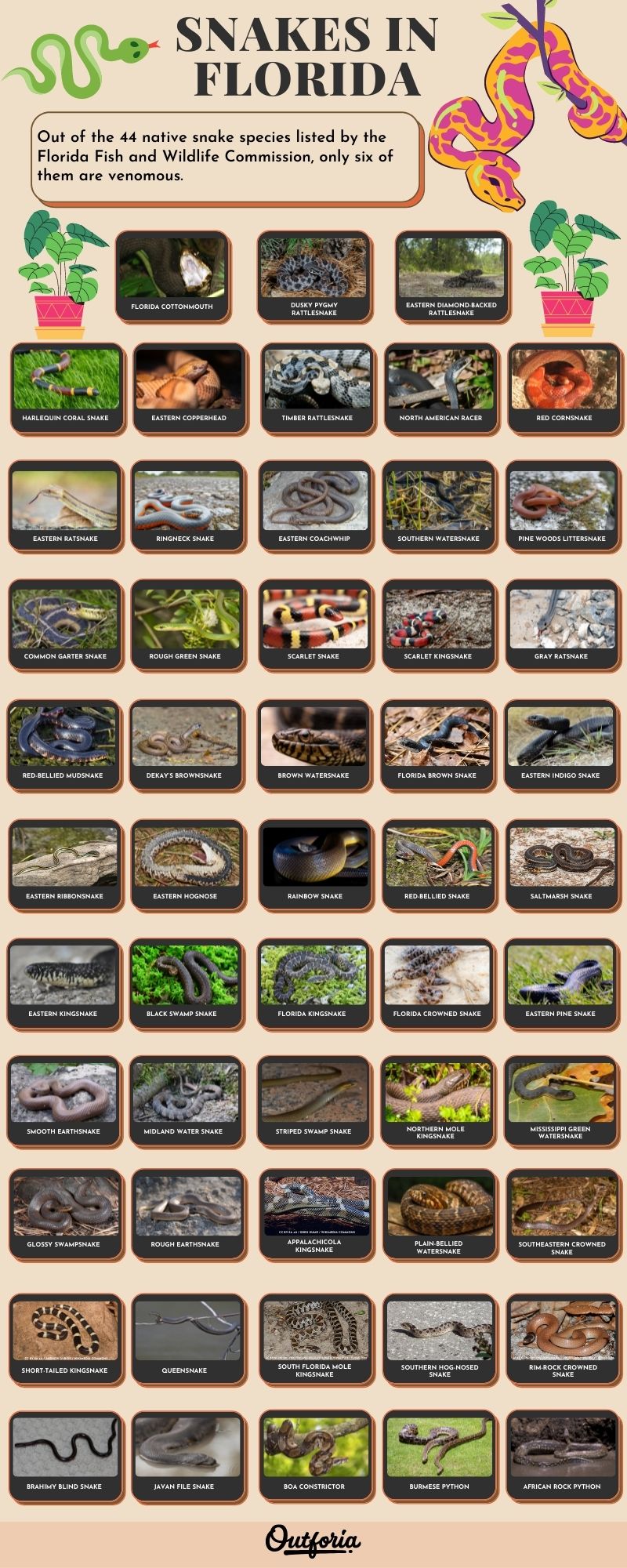
Share This Image On Your Site
<a href="https://outforia.com/snakes-in-florida/"><img style="width:100%;" src="https://outforia.com/wp-content/uploads/2022/02/Snakes-in-florida-infographics-02232022.jpg"></a><br>Snakes in Florida Infographic by <a href="https://outforia.com">Outforia</a>You May Also Like: Discover These 15 Shore Birds in Florida That You Might Have Encountered with Photos, Infographics, Facts, and more!
All The 53 Different Types of Florida Snakes Listed: Identification and Pictures
As previously stated, only six species of snake found in Florida are considered venomous. Those will be the first six we go over in this list, however, they aren’t the only snakes considered to be dangerous to people and pets.
The final five species in the list are invasive species with established populations. We’ll discuss all reported invasive species in a later section.
1. Florida Cottonmouth
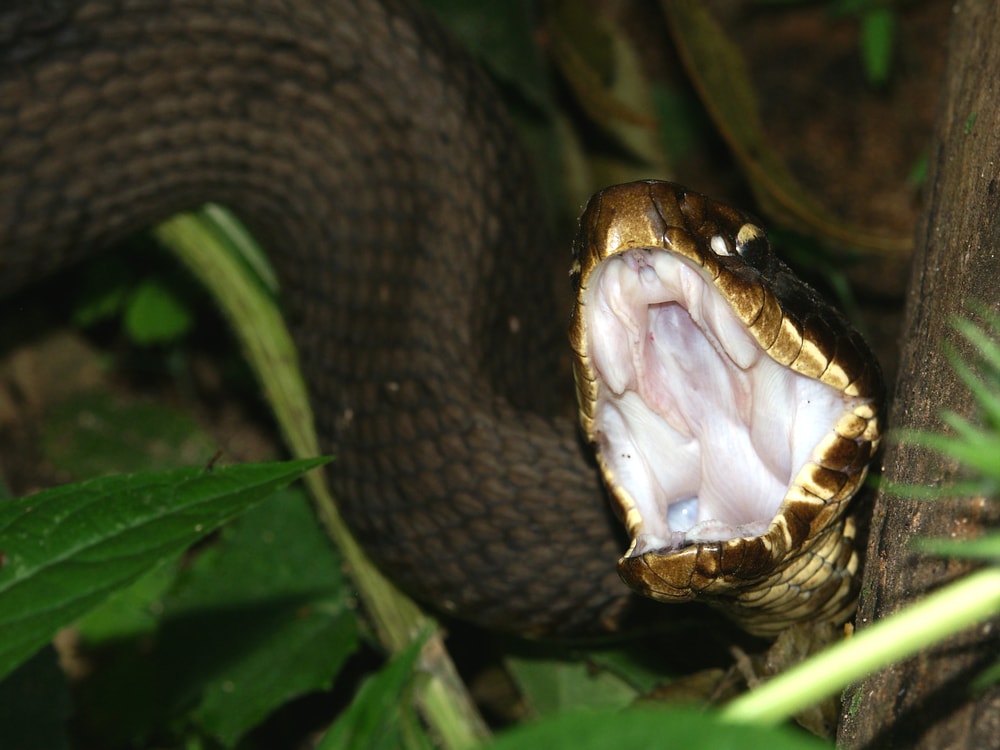
The Florida Cottonmouth (or Water Moccasin) gets its name from the bright white inside of its mouth that becomes visible when it feels threatened and displays by widely opening its jaws. They have brown to black bands all along the body and they darken as they age, looking close to completely black as adults.
On average, a Florida Cottonmouth snake is between 30-48 inches (76-122 cm). While they aren’t aggressive, they are venomous and will strike when cornered. You can find cottonmouths in every single county in Florida, as well as on nearshore islands.
2. Dusky Pygmy Rattlesnake
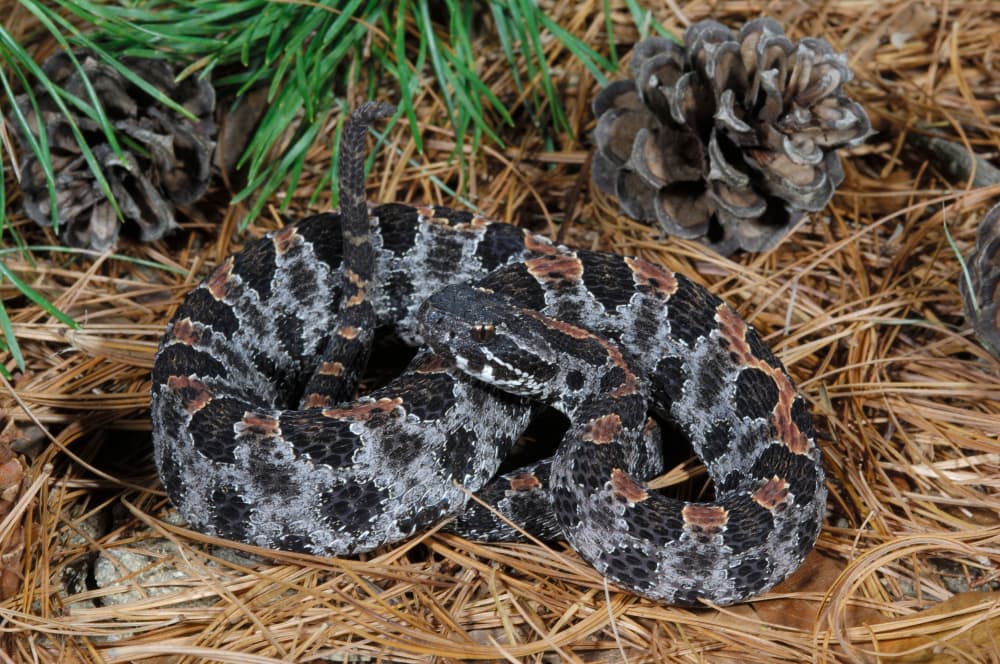
A smaller rattlesnake, the dusky pygmy rattlesnake only grows to between 12-24 inches (30-61 cm). They have beautiful coloring, typically having a gray body with a line of charcoal blotches atop a reddish line going down their back.
Like all rattlesnakes, the dusky pygmy is a venomous snake and can be found in every county in Florida. No sightings have been reported in the Florida Keys, however, they have been found on nearshore barrier islands elsewhere.
3. Eastern Diamond-backed Rattlesnake
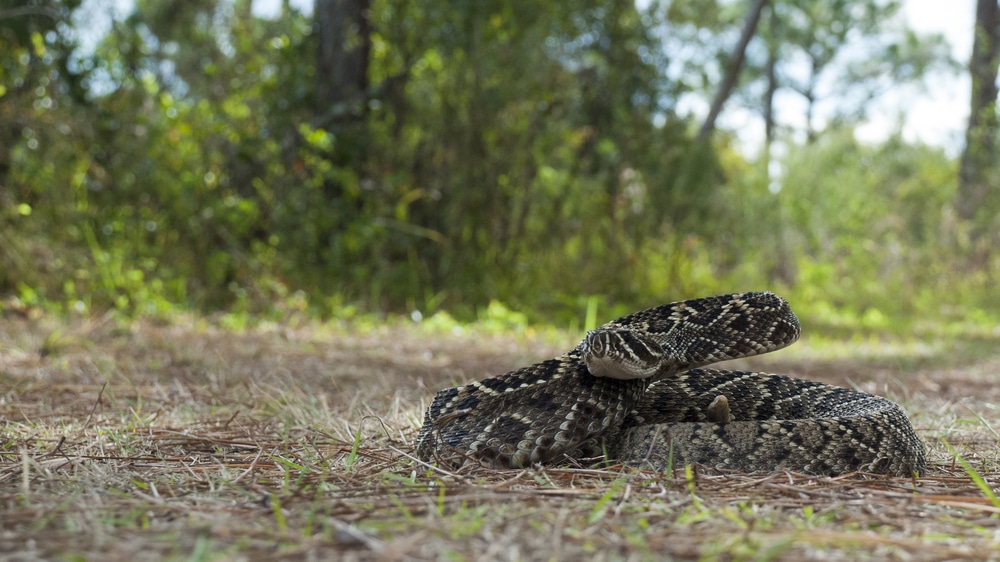
The Eastern Diamondback rattlesnakes found in Florida are exactly like the ones you can find in Texas and other southern states. They have big, thick bodies with a diamond-shaped pattern running down their sides and back. Their telltale rattle will alert you if you wander too close to one.
You can find diamondback rattlers in every county of the state and on nearshore islands. They typically grow to lengths between 33-72 inches (84-183 cm) and are one of the most venomous snakes found in Florida.
4. Harlequin Coral snake
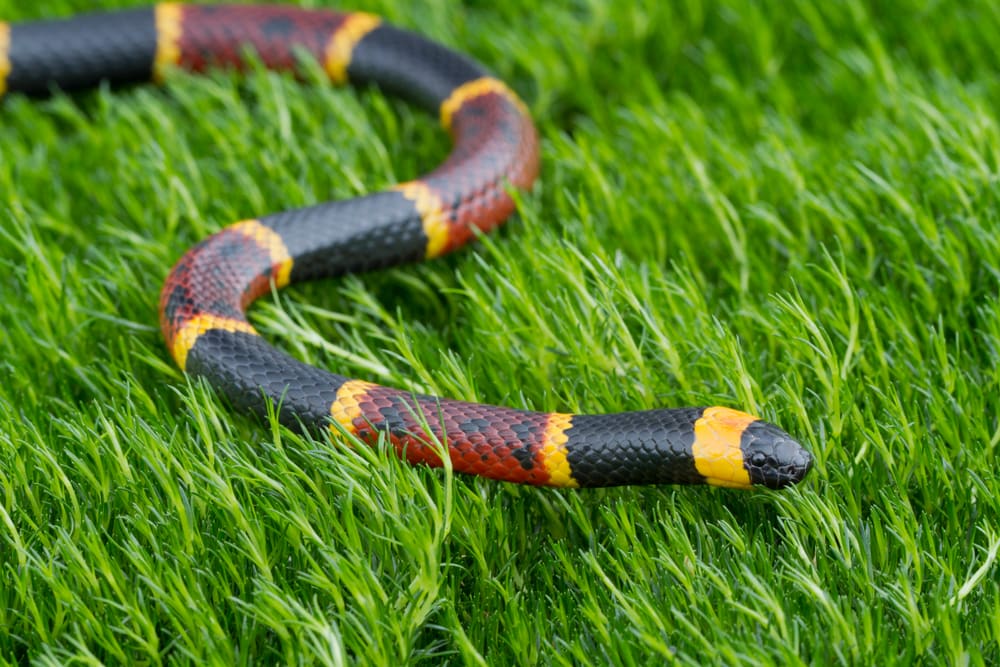
Also known by the simpler name “Coral Snake,” the harlequin coral snake is a venomous snake in Florida that can be easily confused with the non-venomous king snake. Coral snakes have thin bodies with an alternating pattern of red and black bands, separated by thin yellow rings.
To tell them apart you can use the rhyme “red touching black, safe for Jack. Red touching yellow, kill a fellow.” This doesn’t work everywhere in the world but is almost always a correct identifier in Florida.
On average, coral snakes grow to lengths between 20-30 inches (51-76 cm). They can be found in every county in the state, as well as nearshore islands and the Florida Keys.
5. Eastern Copperhead

Eastern copperheads can be tough to see when they’re hiding in leaf litter thanks to their brownish crossbands and tan coloring. On average, these snakes grow to lengths of 22-36 inches long (56-91 cm).
Unlike the majority of other venomous snakes on this list, copperhead bites are rarely life-threatening to adult humans or large pets. They’re more dangerous for small animals and children but are generally just very painful. Copperheads are found almost exclusively in the Panhandle region of Florida, with a range extending eastward to the Apalachicola River.
6. Timber Rattlesnake

Timber rattlers have a similar body shape to a diamondback rattler but have large chevron bands on their pinkish to light gray bodies. Their tail is almost completely black, and they have a large rattle that acts as a warning system.
On average, timber rattlesnakes grow to lengths of 36-60 inches (76-152 cm). They have a range limited to only twelve counties in Northern Florida, though they may be able to venture further south.
7. North American Racer
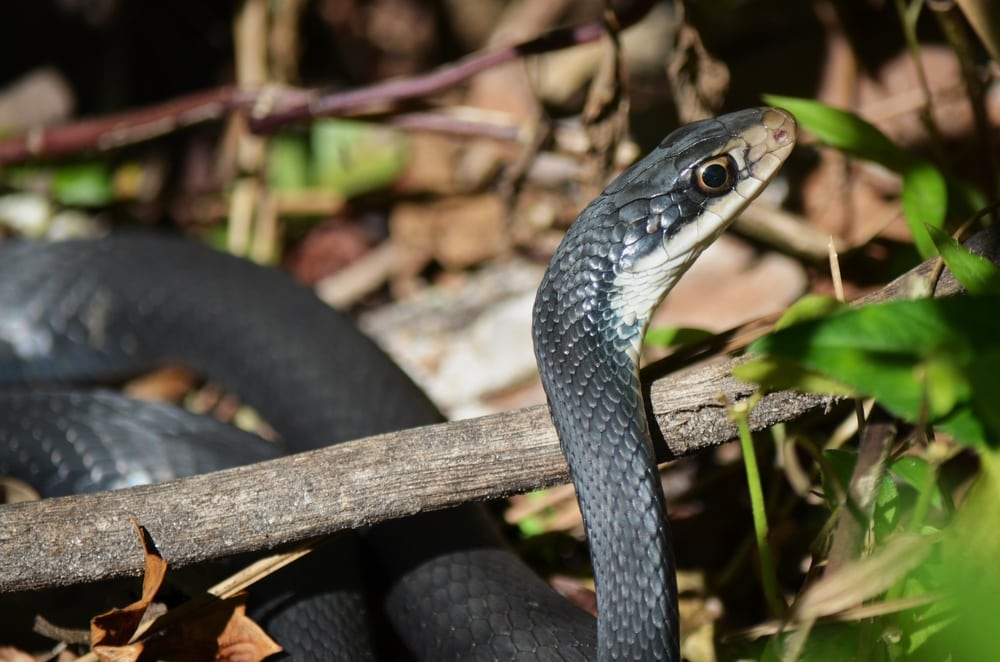
North American racers are slender black snakes with predominant eyes. Their chin and throat have white markings, as well as spots on their bellies, and juveniles can have reddish blotches running down their backs.
On average, these snakes grow to lengths between 20-56 inches (50-142 cm). They’re not venomous to humans and can be found in every county in Florida, as well as the Florida Keys and on barrier islands.
8. Red Cornsnake
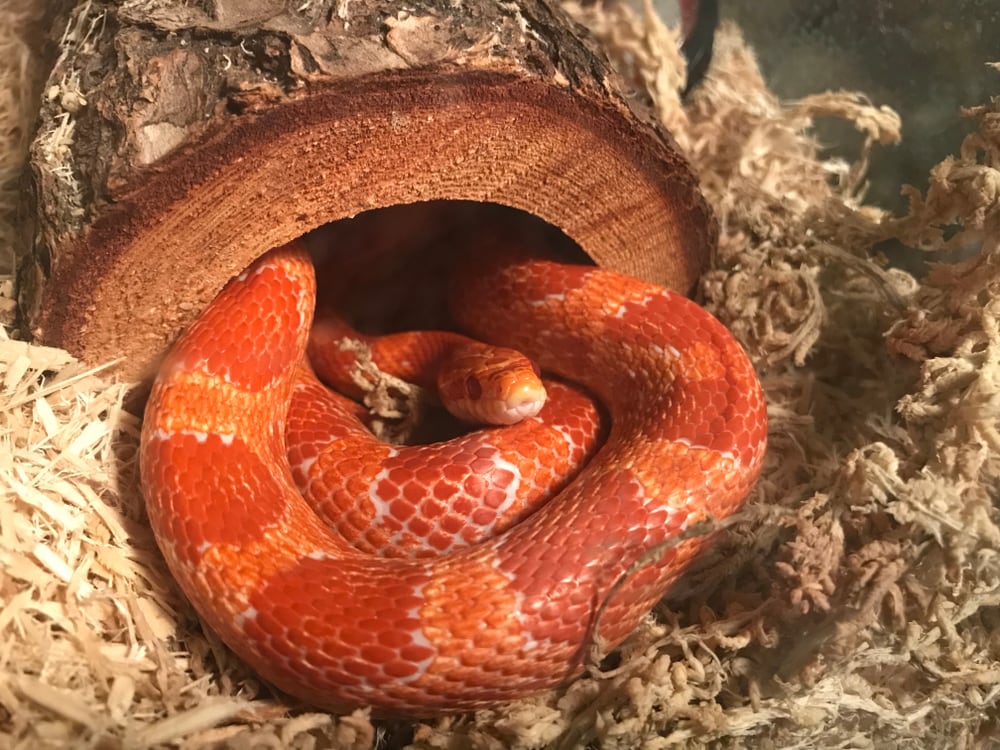
Red corn snakes are actually an orangish-brown color, with black-ringed spots that can be red, orange, or brown. They tend to have a spear-shaped pattern on the back of their head. Most often, you’ll find these non-venomous snakes hiding in old buildings and waiting for rats.
On average, red corn snakes grow to lengths of 30-48 inches (76-122 cm). They’re found in every county in Florida, as well as the Florida Keys.
9. Eastern Ratsnake
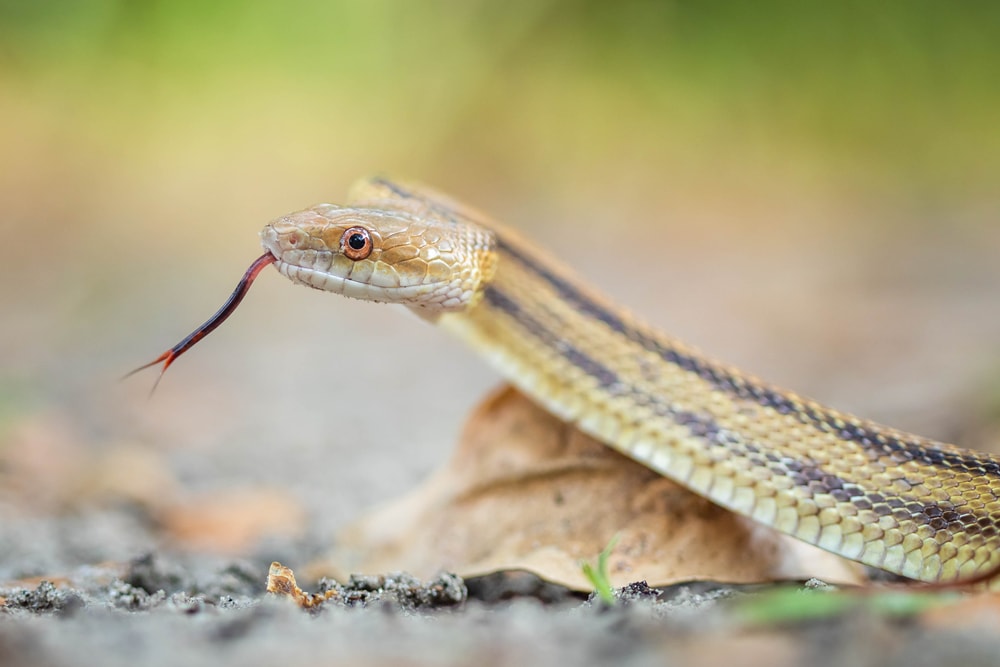
Eastern rat snakes can have different colorations depending on where in the state you find them. In the panhandle, both adults and juveniles tend to be gray with darker blotches. In the peninsula of Florida, adults can be yellow, orange, tan, or gray with four stripes running the length of their bodies.
On average, eastern rat snakes grow to lengths of 42-72 inches (106-183 cm). You can find them in the panhandle from Appalachicola eastwards and in the peninsula as far south as Key Largo. In the panhandle, they interbreed with gray rat snakes, leading to a lot of mixing between the species.
10. Ringneck Snake
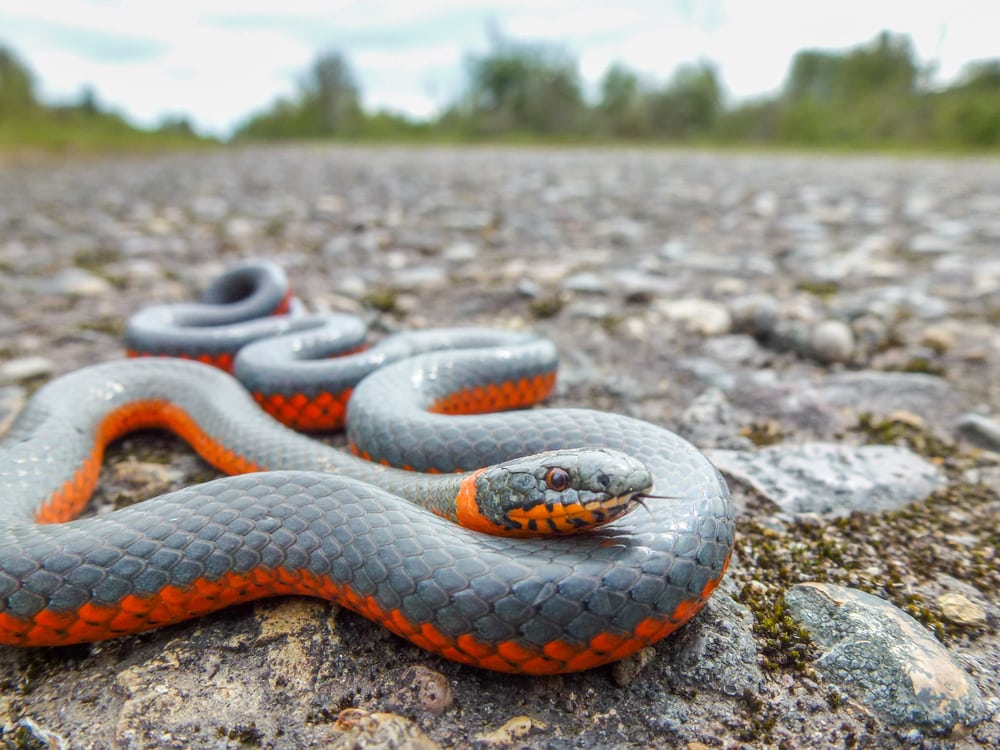
Ringneck snakes can be identified by their slender, black or slate-colored bodies and distinct yellow ring that encompasses their neck. This can be missing in adults, but generally, their bellies are always bright yellow, orange, or red.
On average, these snakes grow to lengths between 8-14 inches (21-36 cm). You can find them in every county of Florida and the Florida Keys. The non-venomous snakes don’t pose a danger to people, pets, or even children.
11. Eastern Coachwhip
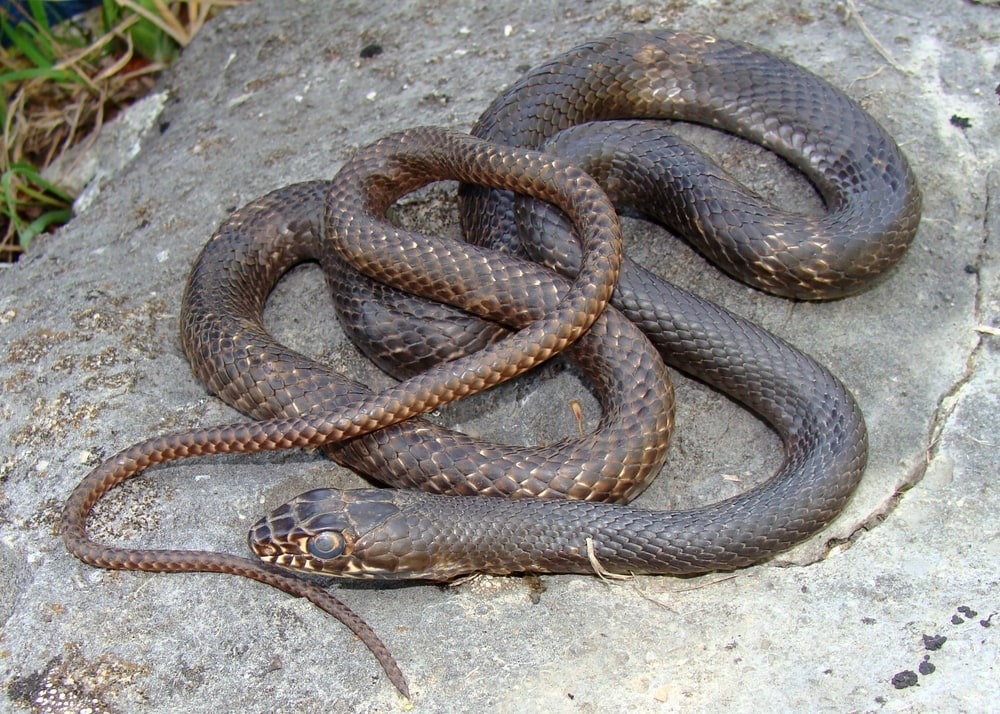
Coachwhip snakes have distinct bodies that make them easy to identify. Their head and the area behind it are a dark color like black or dark brown, while the back end of their body is a light tan or white. They very much resemble the whips they get their name from.
On average, coachwhip snakes grow to lengths between 42-60 inches (107-152 cm). They can be found in every county in Florida, but aren’t found in the Florida Keys or the wetlands near Lake Okeechobee. These non-venomous snakes pose no danger to humans despite reaching nearly five feet in length.
12. Southern Watersnake
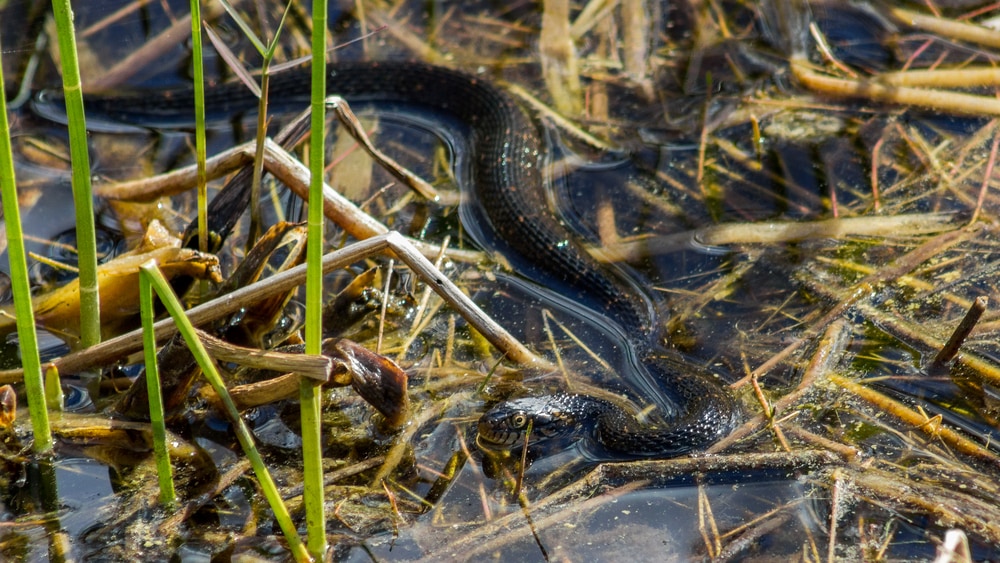
Also known as banded water snakes, the southern watersnake has a thick body lined with crossbands. The broad bands are dark, typically brown, black, or red, and are broken up by thinner, lighter bands.
On average, southern water snakes grow to lengths between 22-42 inches (56-107 cm). You can find them in every county in Florida, but not in the Florida Keys. While completely non-venomous and are not dangerous, they look very much like cottonmouths, and confusing the two species is easy.
13. Pine Woods Littersnake
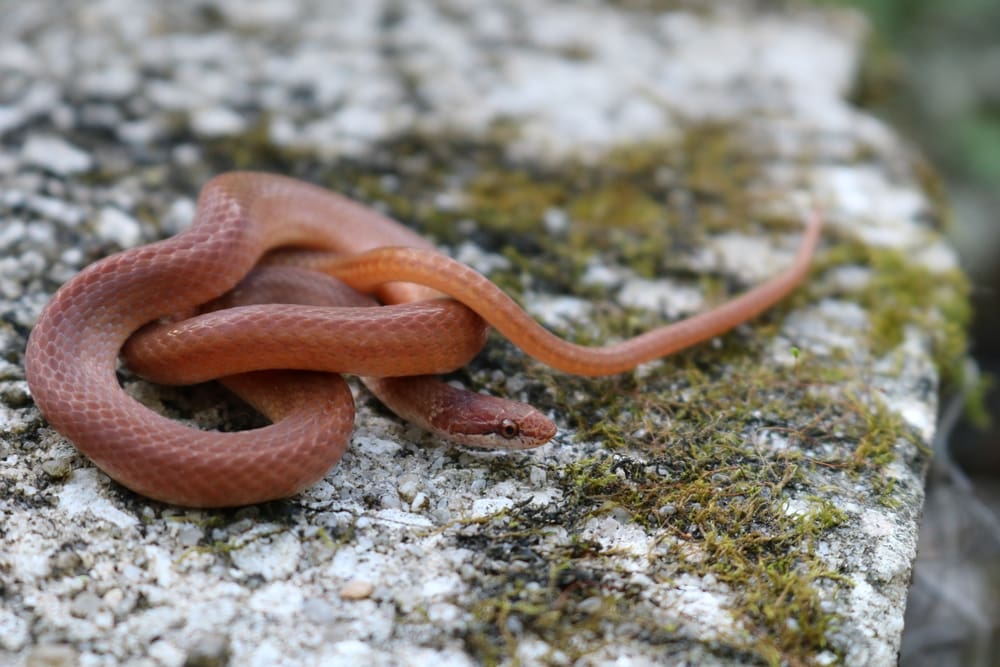
Pine woods litter snakes have slender bodies that are usually a reddish-orange or reddish-brown color. Their lips and bellies are a light shade of white or yellow, and they have a dark line that runs from their eyes to their mouth.
On average, pine woods litter snakes grow to lengths between 10-13 inches (25-33 cm). You can find them throughout the peninsula of Florida, all along the eastern coast of the state, and in the southernmost areas of the panhandle. The non-venomous snakes pose no danger to people.
14. Common Garter Snake
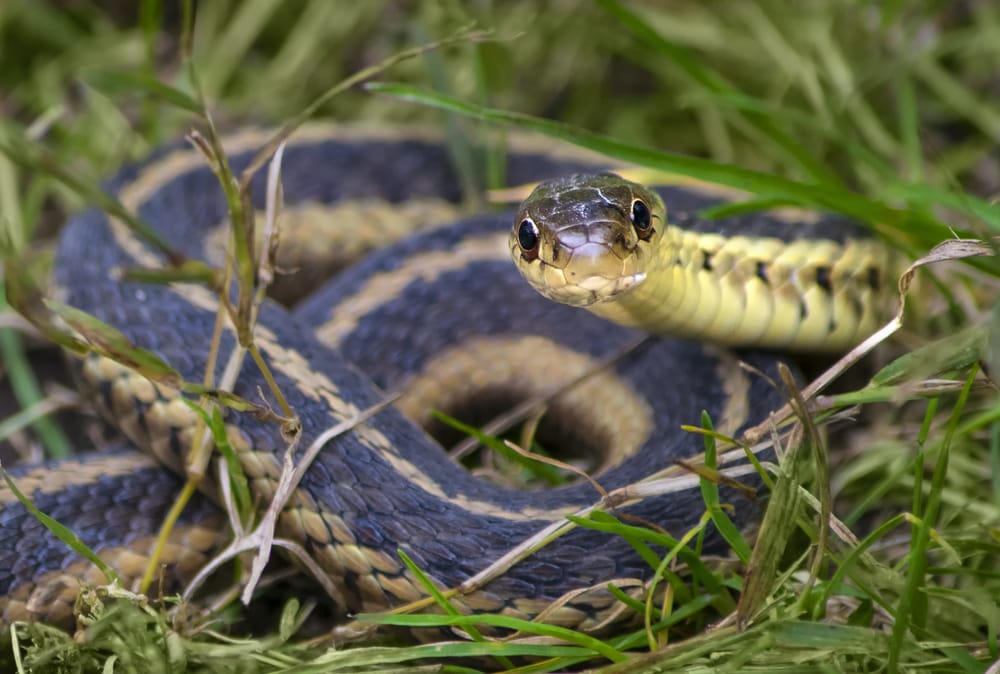
Common garter snakes are long, slender snakes with mostly dark-colored bodies. This can range from black to blue or green to brown. They have three, thin distinct lines running down their bodies that are usually a light color like yellow or white. They can also have checkerboard patterns, dark stripes, or complex patterns.
Garter snakes grow to lengths of 18-26 inches (46-66 cm) on average. These completely harmless and non-venomous snakes can be found across the entire state, and are considered exceptionally rare in the Florida Keys.
15. Rough Green Snake
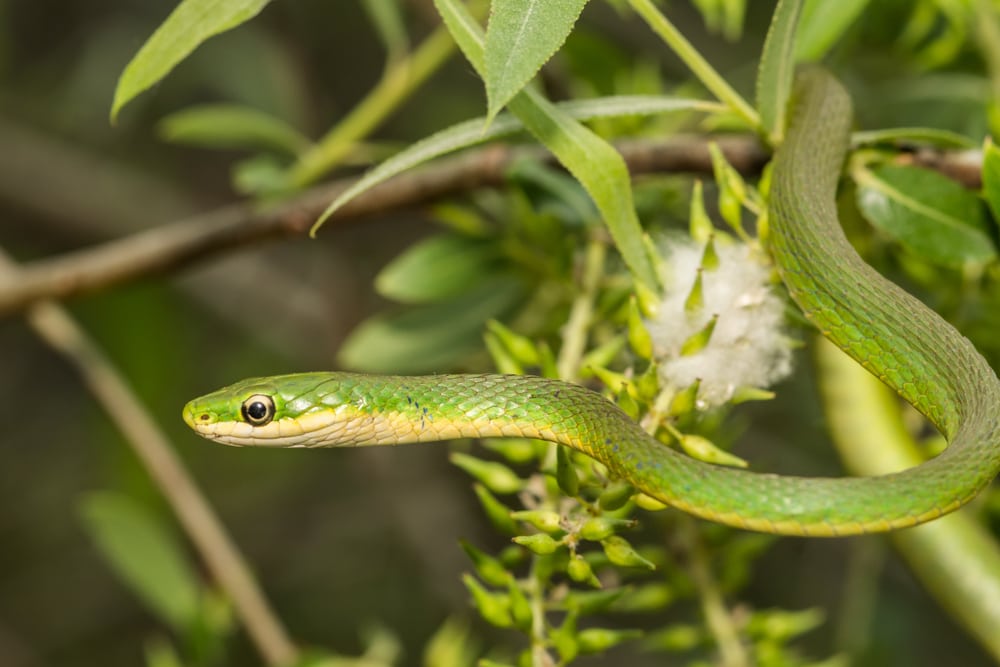
Rough green snakes get their name from their bright green-colored bodies. They have yellow or tan bellies and spend most of their time eating insects from the branches of bushes or small shrubs where they blend in well.
On average, a rough green snake will grow to lengths between 14-33 inches (35-82 cm). These non-venomous snakes are found in every county in Florida, the Florida Keys, and on barrier islands close to shore.
16. Scarlet Snake
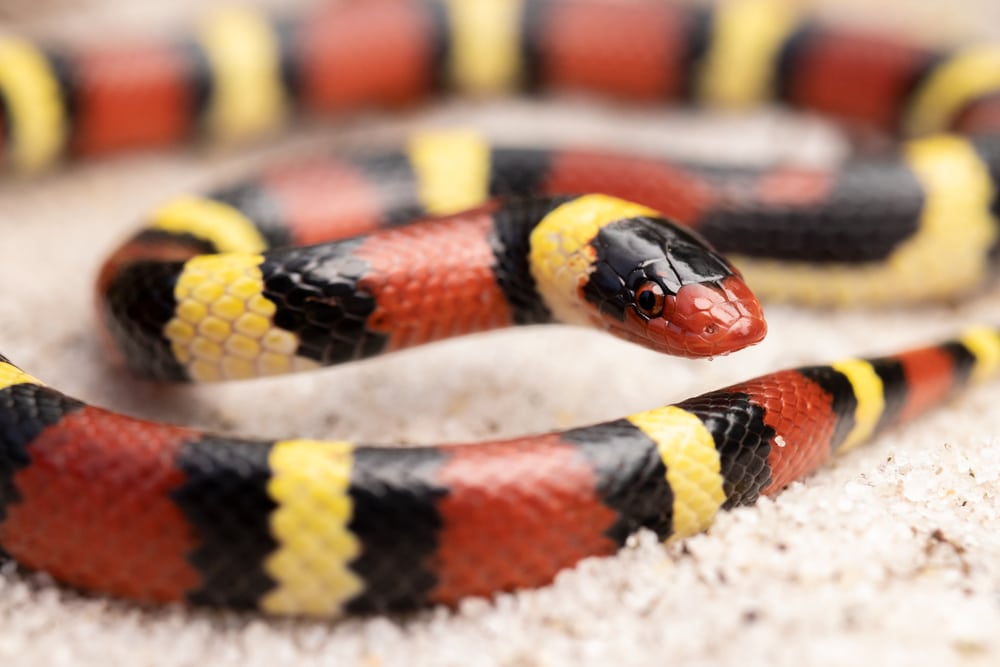
Scarlet snakes are commonly confused for scarlet kingsnakes or coal snakes. Instead of rings that go around their entire body, they have large blotches that almost mimic the rings of those other species. They have a white or light-colored underside, with black-bordered red blotches that cover large sections of their body.
On average, scarlet snakes grow to lengths between 14-20 inches (36-51 cm). They can be found everywhere in Florida except the Florida Keys. As non-venomous snakes, they pose no danger to humans or pets.
17. Scarlet Kingsnake

Scarlet Kingsnakes look very much like venomous coral snakes. They have thin bodies covered in alternating rings of black, red, and white or yellow. On these snakes, the red and yellow rings never touch, hence the previous rhyme.
On average, scarlet kingsnakes grow to lengths between 14-20 inches (36-51 cm). They can be found in every county of mainland Florida, with two reports in the Florida Keys. These non-venomous snakes pose no danger to people.
18. Gray Ratsnake
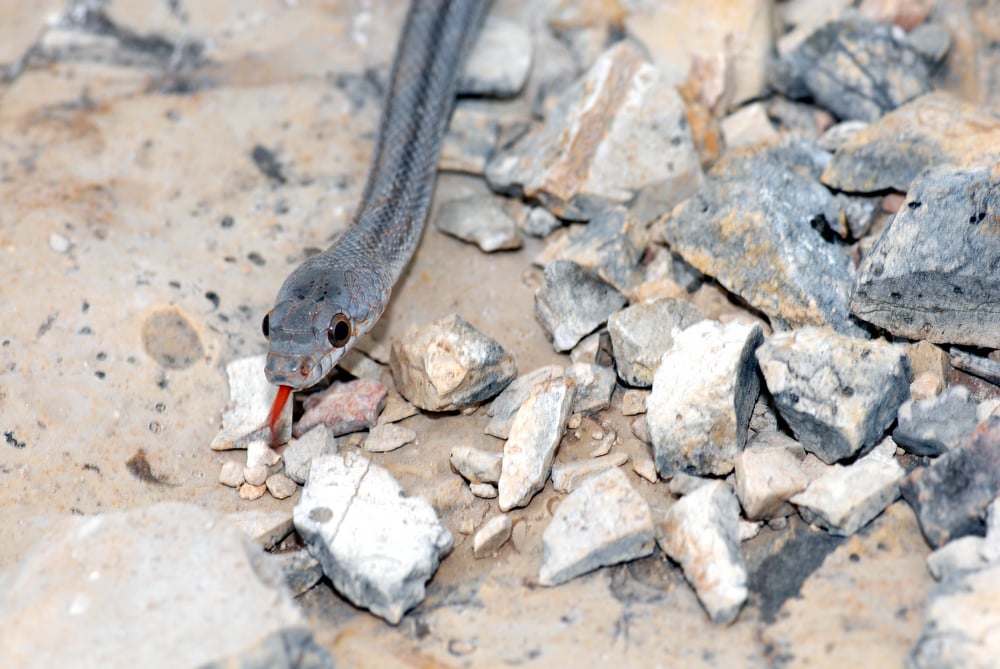
Gray rat snakes are long-bodied snakes that are mostly a light gray color with darker gray blotches. They have sandy or lighter-colored bellies than backs, and juvenile snakes share color patterns with adults.
On average, gray rat snakes grow to lengths between 42-72 inches (106-183 cm). You can find them in the panhandle of Florida, west of the Apalachicola River. They often breed with eastern rat snakes, leading to a mixing of both non-venomous species.
19. Red-bellied Mudsnake
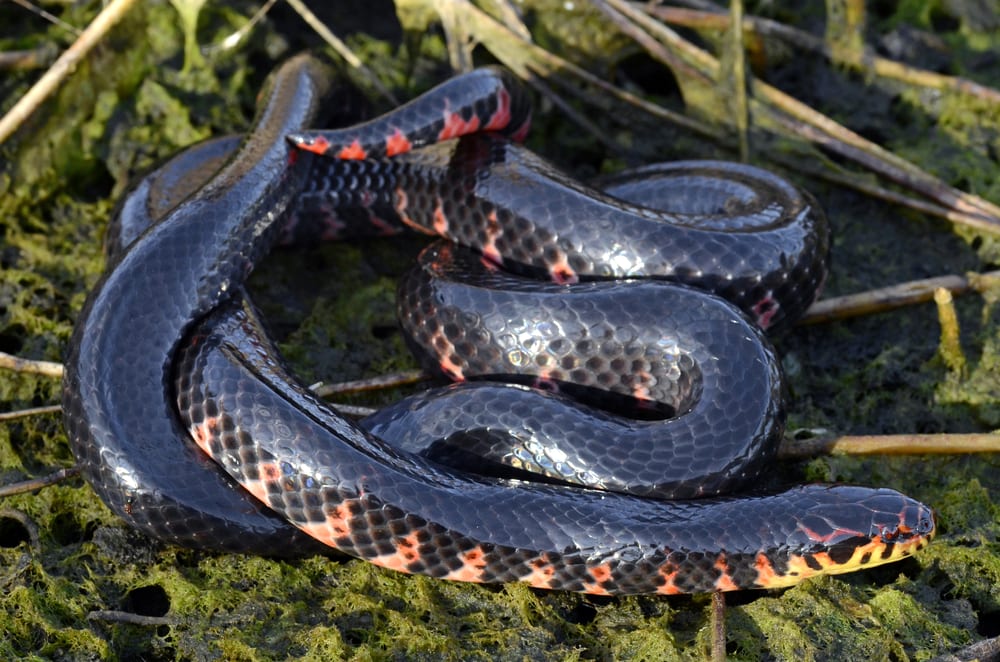
Mud snakes have thick bodies with beautiful color patterns. In the sun, they shine an iridescent blue, but their body is primarily a glossy black color with red or pink bars covering the belly. Their iris is a red color, and they have distinct yellow scales on their throat, mouth, nose, and chin that have a dark spot on them.
On average, mud snakes grow to lengths between 40–54 inches (102–137 cm). These non-venomous snakes prefer slow-moving water and can be found throughout the state aside from the Florida Keys.
20. Dekay’s Brownsnake
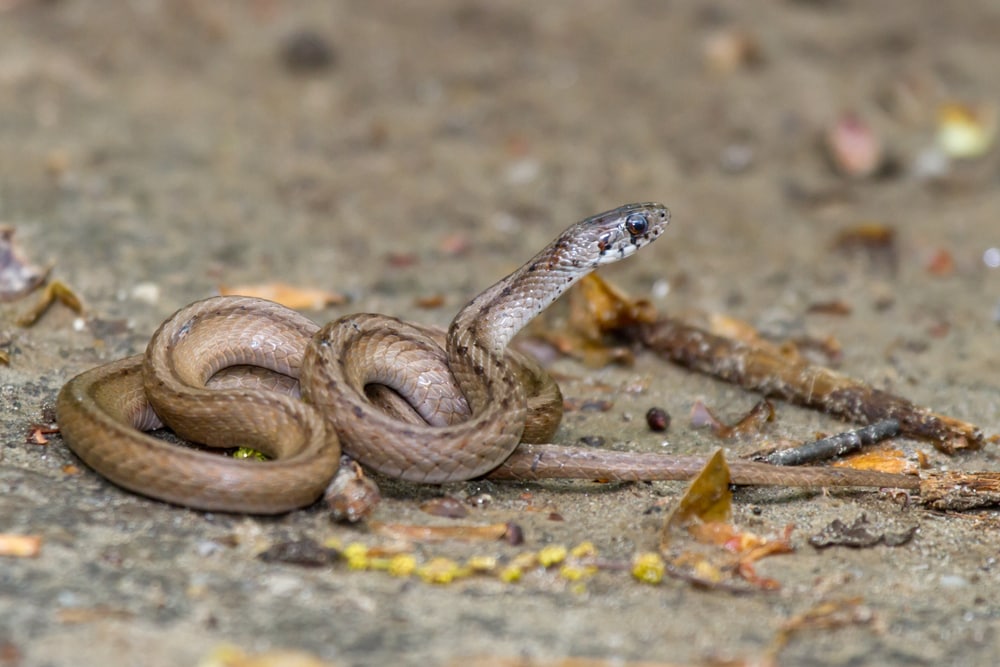
These brown snakes are extra-slender and can range from a light tan to a darker brown color. You can identify them by the line that traces their spine, as it’s paralleled by a row of dark spots on each side. They tend to have a dark head and neck compared to the rest of their body.
Dekay’s Brown snakes grow to lengths between 9-13 inches (23-33 cm). You can find them in the panhandle region, west of the Aucilla River. They’re nonvenomous and very small, posing no threat to anyone.
21. Brown Watersnake
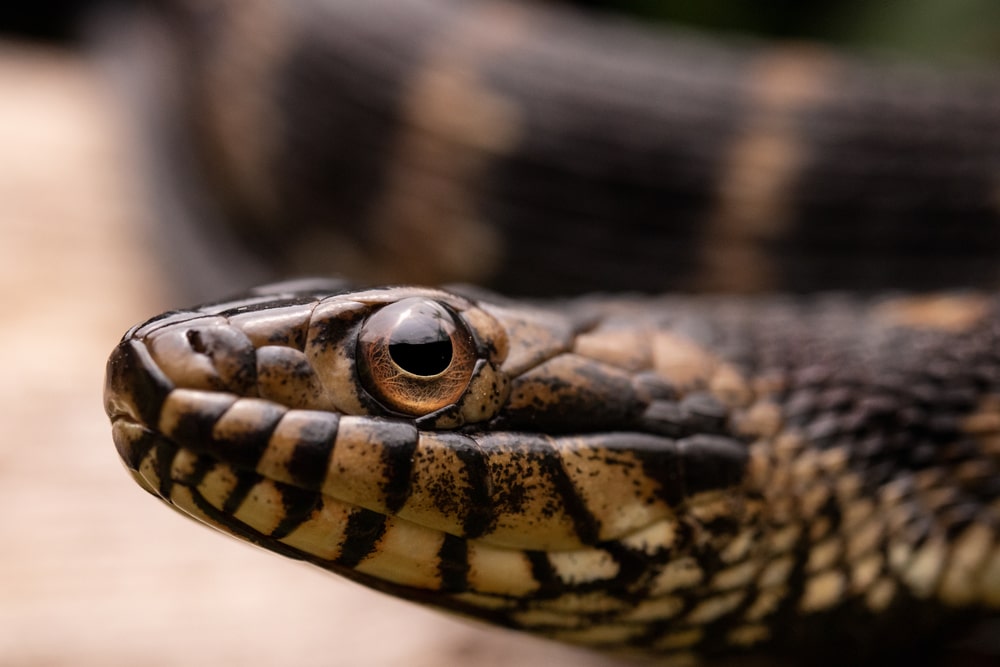
Brown water snakes are usually found near water (duh) and have a dark brown body with black or darker brown, square blotches. They have huge heads that are great for catching amphibians, but you could still mistake them for a cottonmouth or rattler.
On average, brown water snakes grow to lengths between 30-60 inches (76-152 cm). You can find these nonvenomous snakes throughout mainland Florida.
22. Florida Brown Snake
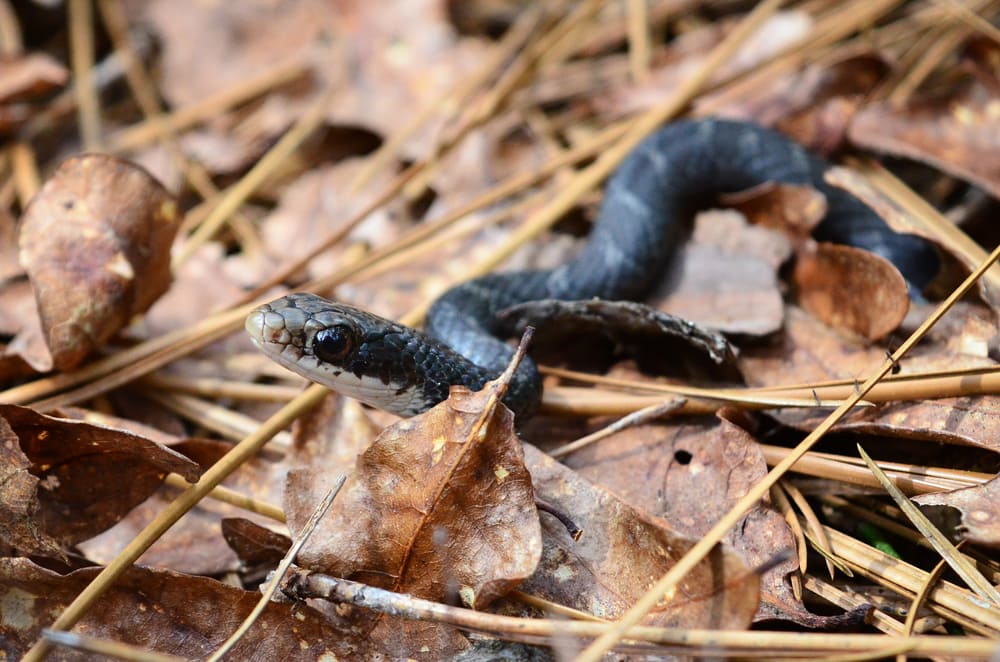
Florida brown snakes are small, thin snakes that are usually a brown, light brown, or tan color. They have a lighter line that runs down their back, parallel lines of dots that follow that line, and white upper lips. Under their eyes are dark marks that make them look eternally exhausted.
On average, these snakes grow to lengths between 9-13 inches (23-33 cm). You can find them on the east coast of Florida, north of Duval County, as well as in the Upper Florida Keys.
23. Eastern Indigo Snake
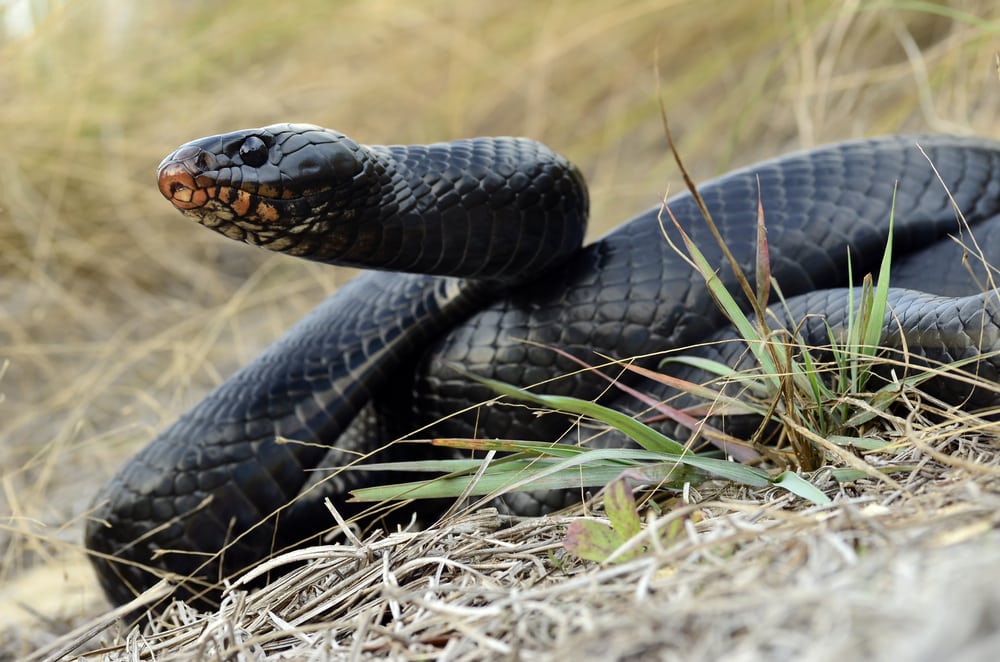
Indigo snakes are a large, gorgeously colored species. Most of their body is glossy black, but they have iridescent colors that can range from blue to purple in the sunlight. Their chins tend to be an orange or reddish color, while juveniles have light-colored rings on the body.
On average, eastern indigo snakes grow to lengths between 60-82 inches (152-213 cm). You can find these large but non-venomous snakes throughout the entire state of Florida, though they are listed as a threatened species by the state.
24. Eastern Ribbonsnake
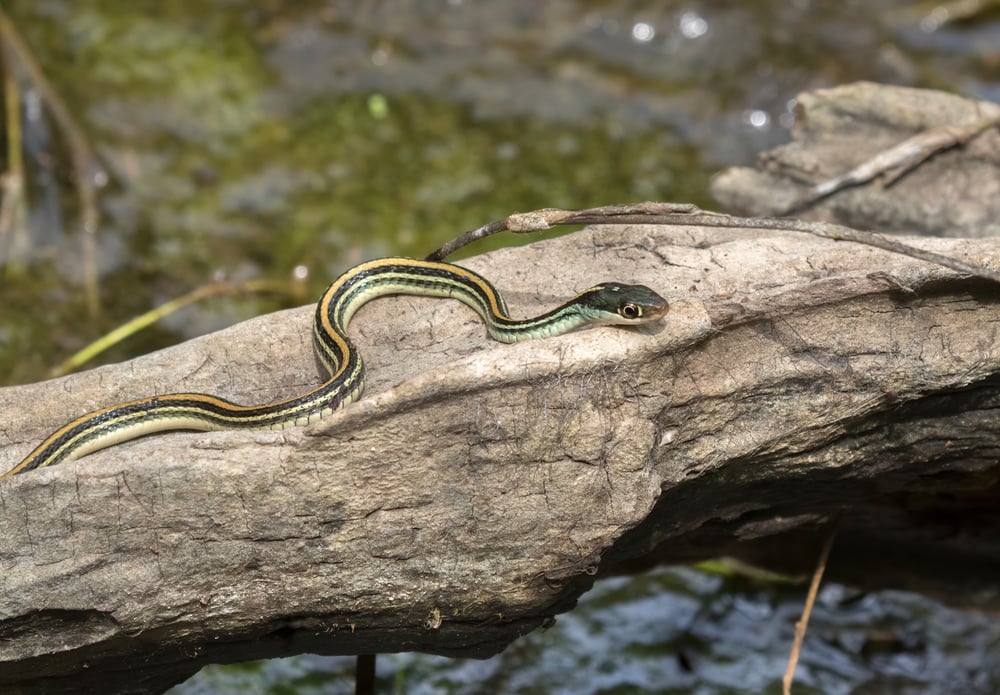
Eastern ribbon snakes are incredibly slender, with three light stripes running the length of their bodies. They tend to have a darker-colored base color, from black to olive green. Their stripes can range in color from white and yellow to blue or light green.
On average, these snakes grow to lengths between 18-26 inches (46-66 cm). They can be hard to tell apart from garter snakes, but just like garter snakes, they are non-venomous and not dangerous. You can find them throughout Florida including the Florida Keys.
25. Eastern Hognose
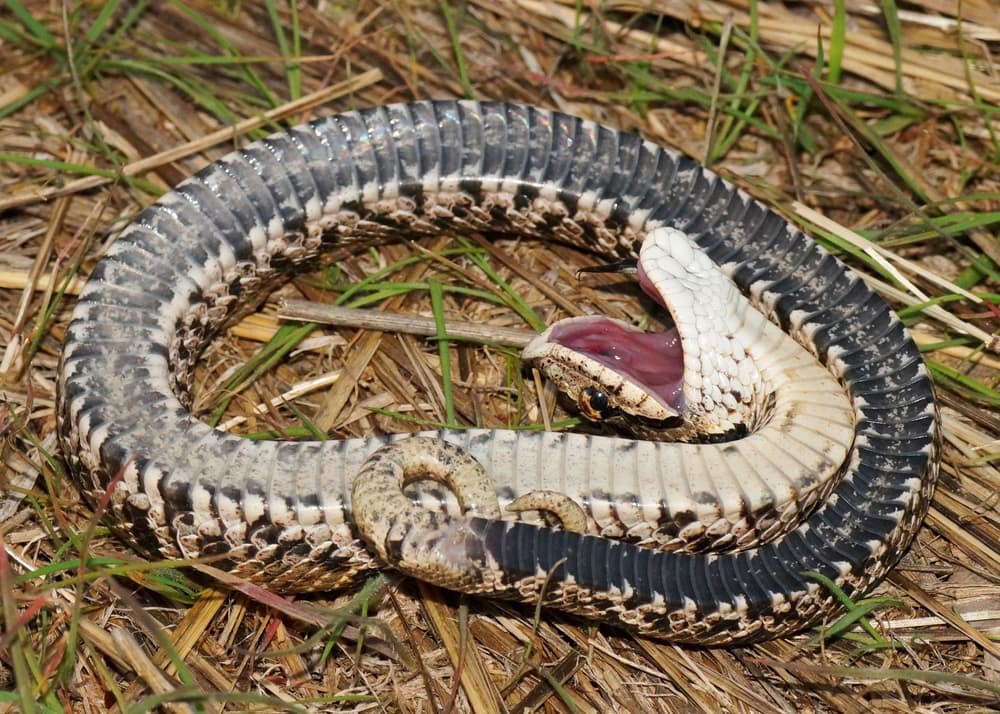
Easter hognose snakes get their name from the way they seem to have an upturned nose, much like a pig’s snout. They have stocky bodies that have a wide variety of color patterns including yellow, tan, olive, brown, gray, orange, reddish-brown with large, dark brown, black, as well as irregular blotches. Some may even be a solid black or brown color, so the nose is the best way to identify them.
On average, eastern hognose snakes grow to lengths between 20-33 inches (51-84 cm). They can be found throughout mainland Florida, and sometimes can be hard to tell apart from dusky pygmy rattlesnakes.
Hognose are super interesting snakes because they produce a mild venom to help subdue prey, but other than some localized swelling it isn’t dangerous to people. They’re considered nonvenomous because of this.
They’re also famous for not biting people, instead, using the tactic of playing dead for defense. They may strike with their mouth closed, convulse on the ground, poop themselves, throw up, or let out a bad-smelling odor.
26. Rainbow Snake
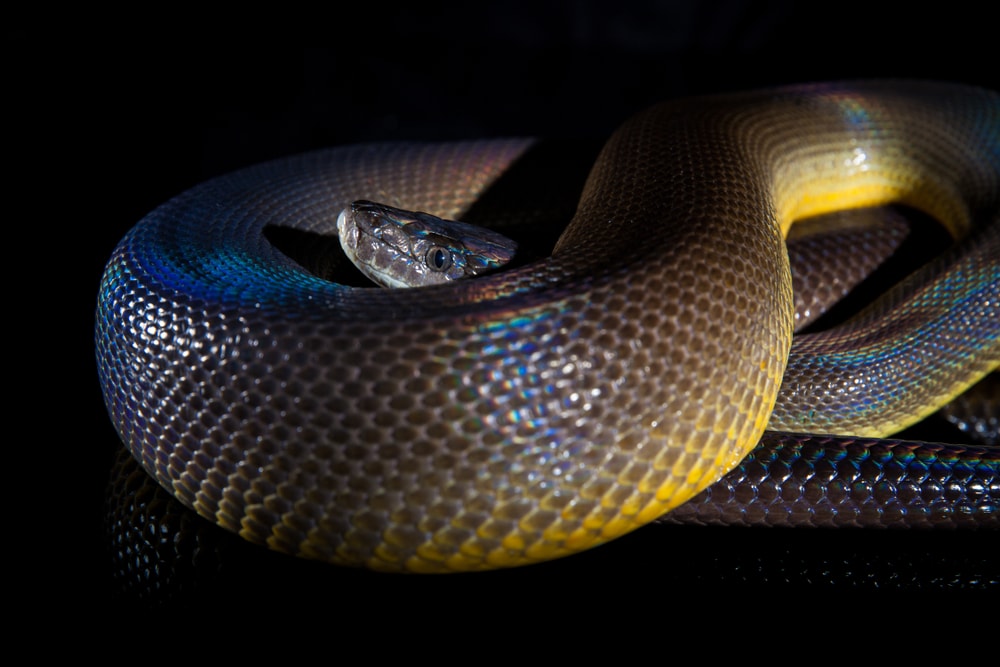
Rainbow snakes have thick bodies that are mostly glossy black. In the sunlight, they give off an iridescent blue color from their black scales. They have three red stripes running down their body, as well as a yellow or pink belly, mouth, and chin. Their tail has a pointed scale at the tip.
On average, rainbow snakes grow to lengths between 27–48 inches (70–122 cm). These nonvenomous snakes are mostly found in the panhandle of Florida and are great swimmers.
27. Red-Bellied Snake
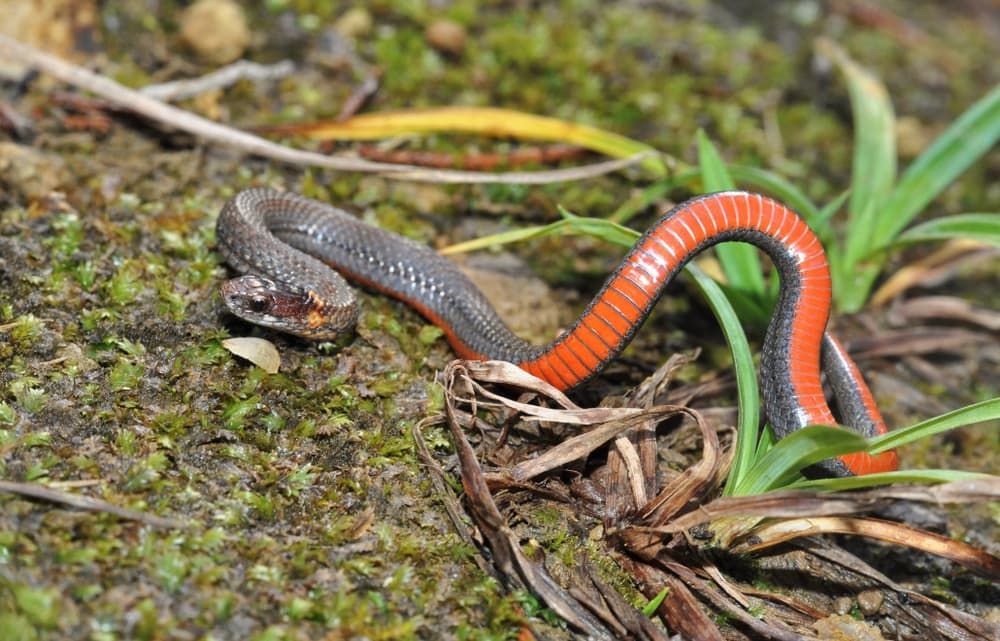
Red-bellied snakes are small and thin, with a mostly gray or reddish-brown body color. They have dark-colored heads and bright red bellies.
On average, red-bellied snakes grow to lengths between 8-10 inches (20-26 cm). You can find these nonvenomous species in the northern portions of Florida, including the Panhandle.
28. Saltmarsh Snake
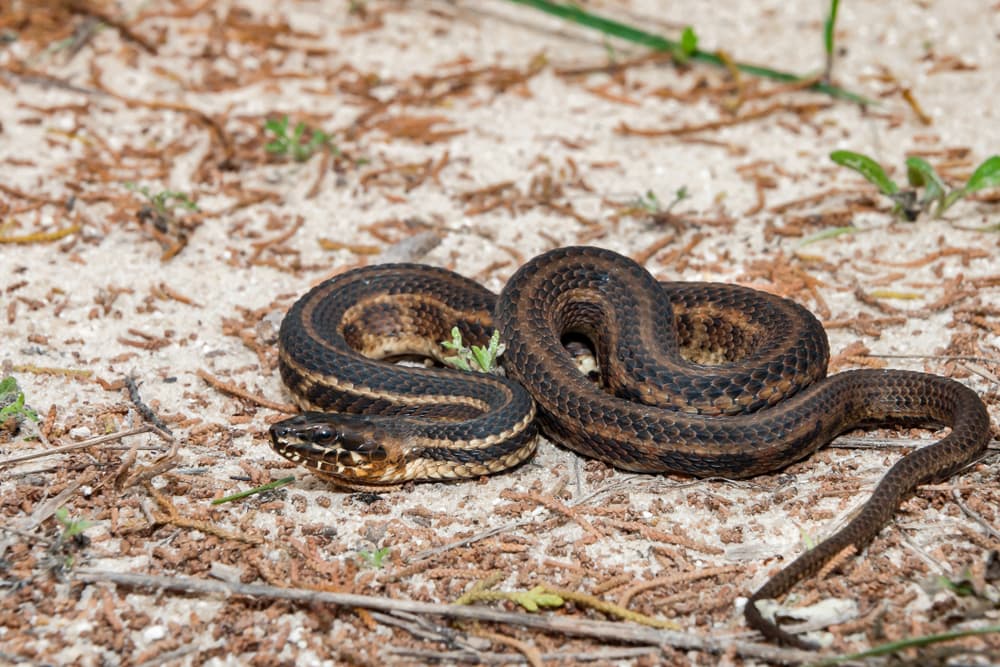
Saltmarsh snakes tend to be a darker color, ranging from rusty-orange to olive green. Many individuals have a lighter-colored stripe running down each side of their body, but this may be absent.
On average, saltmarsh snakes grow to lengths between 15-30 inches (38-76 cm). You can find them throughout most of the state along the coasts and on barrier islands. They spend most of their time in the salt grasses searching for small prey animals.
29. Eastern Kingsnake
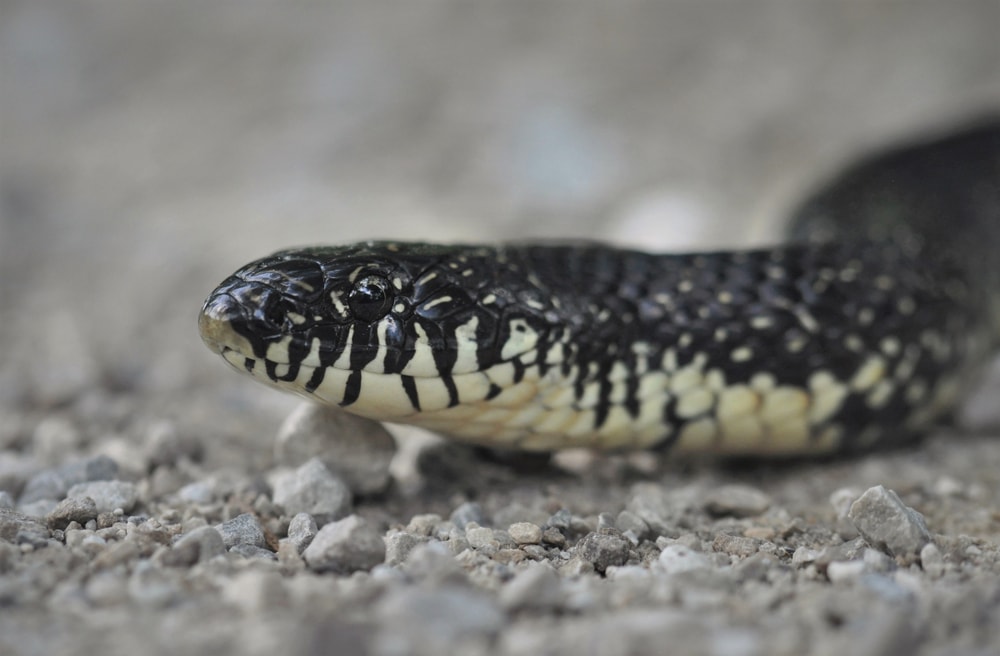
Eastern kingsnakes have similar bodies to other kingsnakes but have either a chocolatey brown or black-colored body. Their blotches are almost like rings and are a light yellow or whitish color.
On average, eastern kingsnakes grow to lengths between 36-48 inches (90-122 cm). These nonvenomous snakes can be found in the Panhandle and north of Pinellas County. They’ve also been found on barrier islands and are known to breed with other kingsnake species.
30. Black Swamp Snake
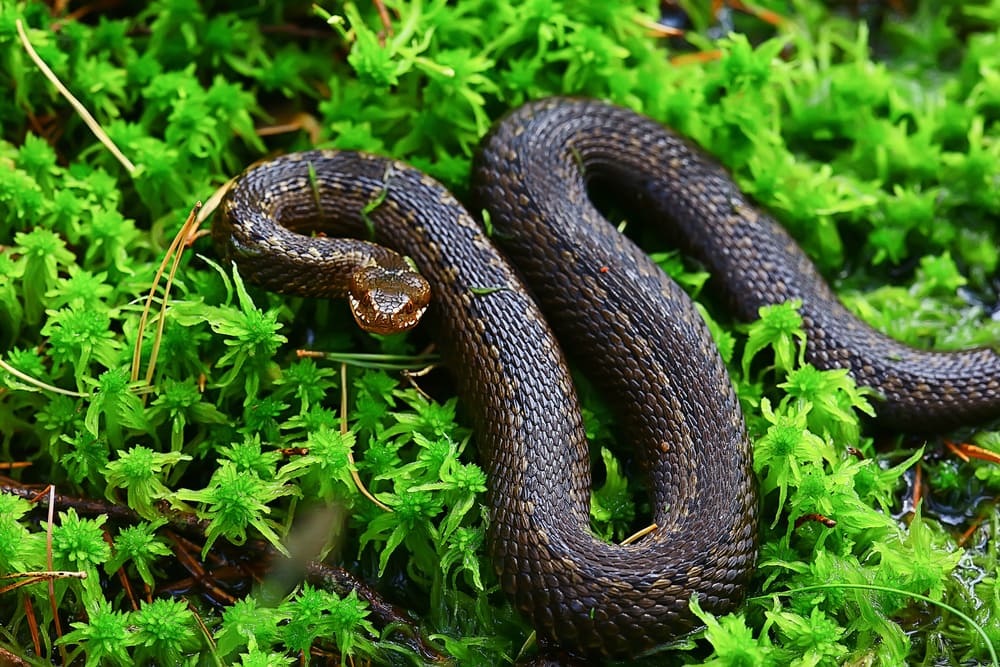
Black swamp snakes have shiny, black backs and brightly colored red bellies. Their top and bottom halves seem to lock together in a zipper-like style.
On average, black swamp snakes grow to lengths between 10-15 inches (25-38 cm). They’re most commonly found in the Panhandle Region and the Central Peninsula.
31. Florida Kingsnake
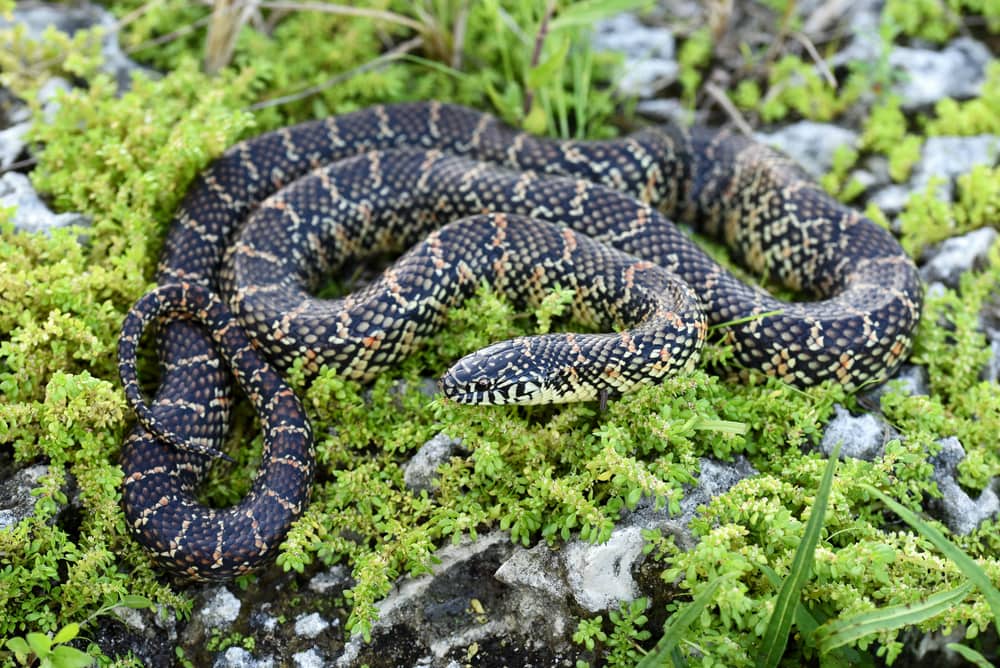
Florida kingsnakes have similar body shapes to other kingsnakes but have distinct colorings that make them stand out. They tend to be yellow to brown on their body, with up to forty yellowish crossbands and a chain link pattern running down their back.
On average, Florida kingsnakes grow to lengths between 36-48 inches (90-122 cm). You can find them south of Taylor County and into the Florida Keys. Like other kingsnakes, they aren’t venomous and pose no danger.
32. Florida Crowned Snake
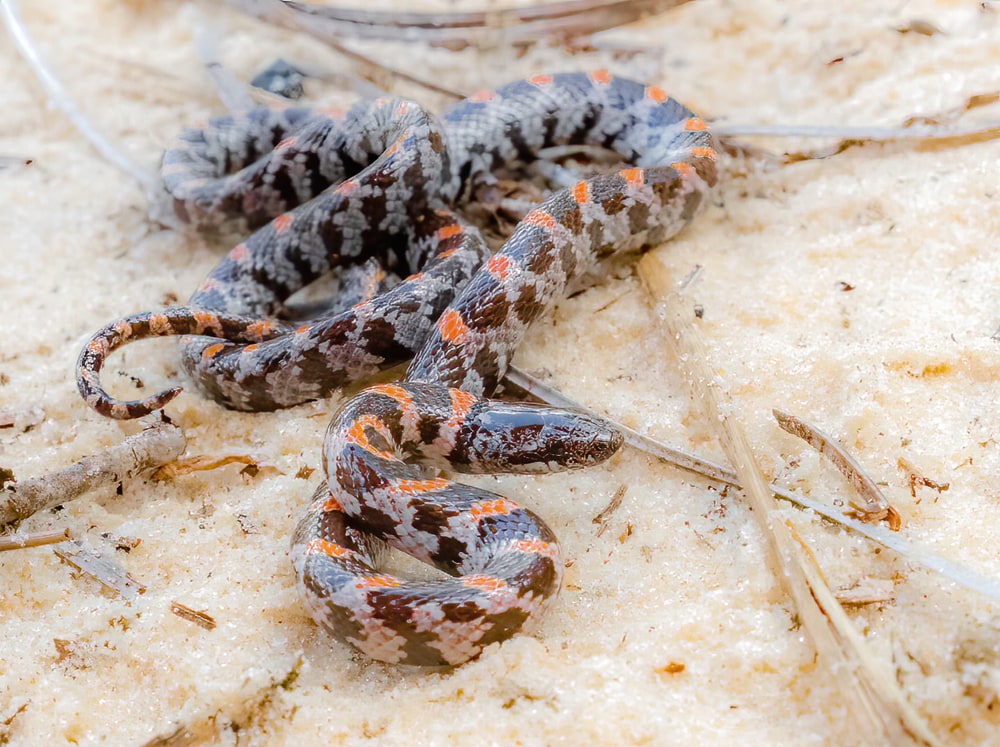
Florida crowned snakes are small and thin, with a tan or light reddish-brown body and a dark brown or black head. They can have a band on the neck behind the head and they have a light-colored underside.
On average, crowned snakes grow to lengths between 7-9 inches (18-23 cm). They can be found in isolated populations throughout the peninsula of Florida, but aren’t known to inhabit the Panhandle region, extreme southern Florida, or the Florida Keys.
33. Eastern Pine Snake
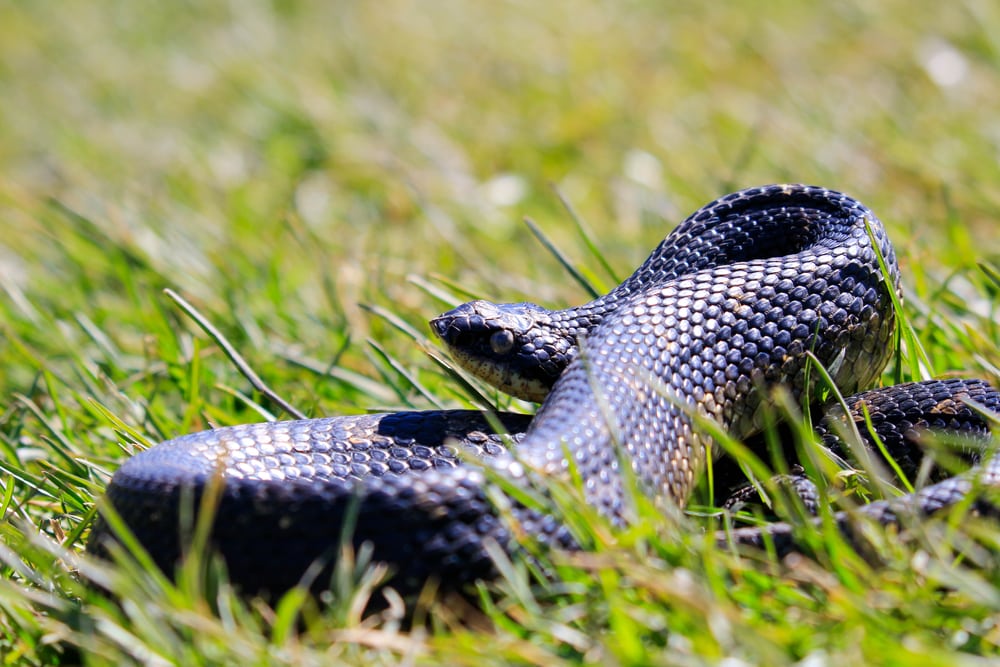
The eastern pine snake has a large, thick body, wide head, and irregular colorations. They tend to have a cream or light-colored body with darker red or brown splotches, but they can lack those spots completely and just be a light color.
On average, pine snakes grow to lengths between 48-66 inches (122-168 cm). You can find them throughout most of the state with the only areas they aren’t found bei8ng the Everglades, extreme southern Florida, the Florida Keys, and Lake Okeechobee.
Despite being large, they’re a nonvenomous species and pose little to no threat to people.
34. Smooth Earthsnake
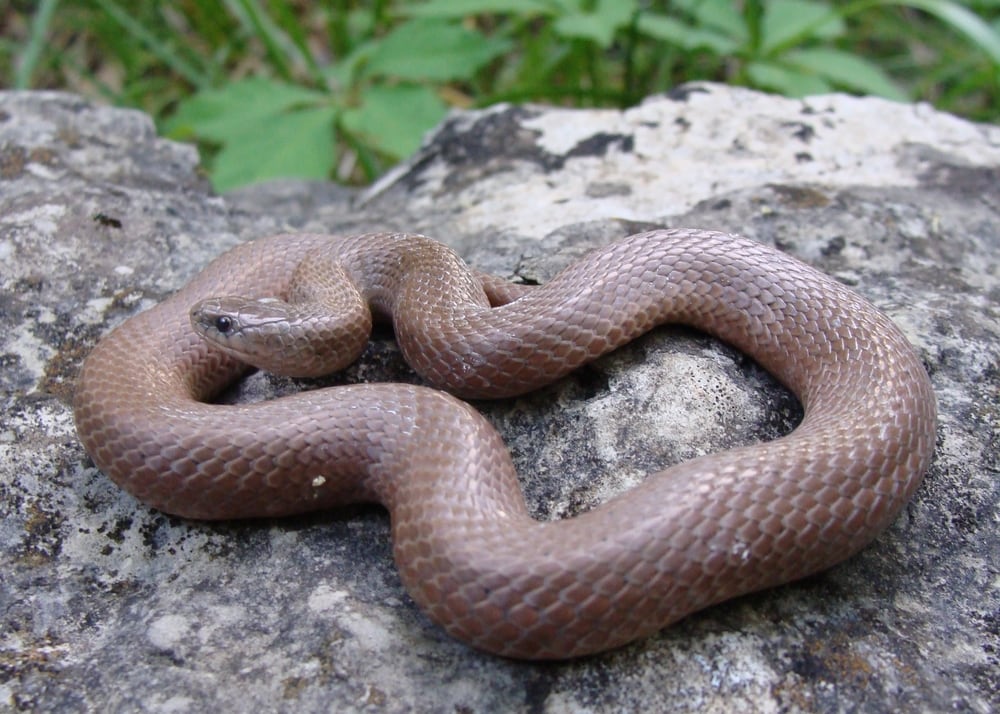
Smooth earth snakes have glossy brown or reddish-brown scales and tiny flecks that could be called spots on their backs. They have a pointed snout that helps them root into the ground and dig through leaf litter.
On average, smooth earth snakes grow to lengths between 7-10 inches (18-26 cm). You can find these nonvenomous snakes throughout the Panhandle region and they have an isolated population in Highlands County, Florida.
35. Midland Water Snake
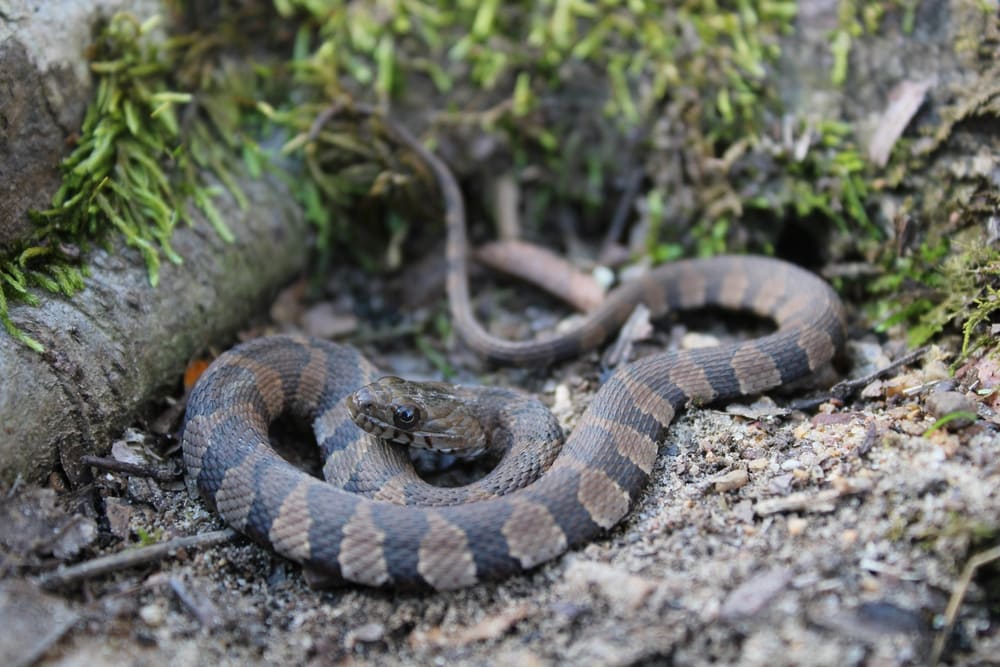
Midland water snakes have thick bodies with dark red or brown crossbands extending from the belly across the back. They have large eyes and the majority of their body is a light tan to light brown color.
On average, these nonvenomous water snakes grow to lengths between 24-30 inches (60-76 cm). These snakes are only found in the western end of the Panhandle region, mostly in the Choctawhatchee, Escambia, and Yellow River basins.
36. Striped Swamp Snake
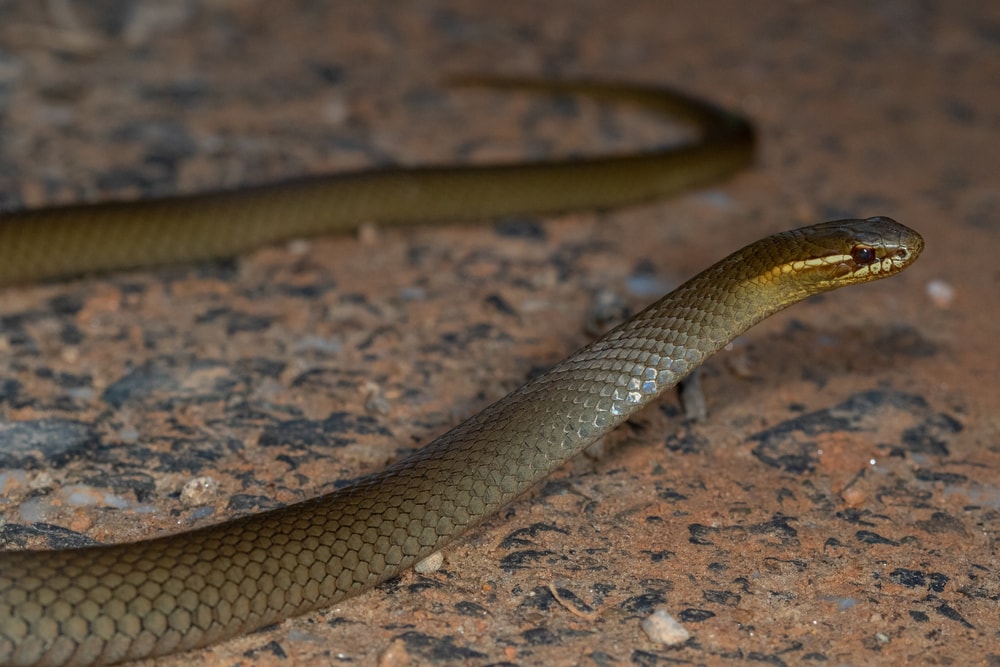
Also known as the crayfish snake, striped swamp snakes have glossy brown bodies with muted-yellow to cream undersides. Their backs have three dark stripes that run from their small head to their tail and they have bright colored lips that contrast their dark heads.
On average, striped swamp snakes grow to lengths between 13-20 inches (33-51 cm). You can find these nonvenomous snakes in the extreme eastern Panhandle region and throughout the Florida peninsula.
37. Northern Mole Kingsnake

Adult mole kingsnakes are gray, brown, or orange-colored and have about 55 red blotches along the length of their back. These seem to fade as they get older, with cases of old individuals seemingly having no blotches.
On average, mole kingsnakes grow to lengths between 30-42 inches (76-107 cm). You can find these nonvenomous snakes from the Panhandle regions to Franklin and Liberty counties.
38. Mississippi Green Watersnake
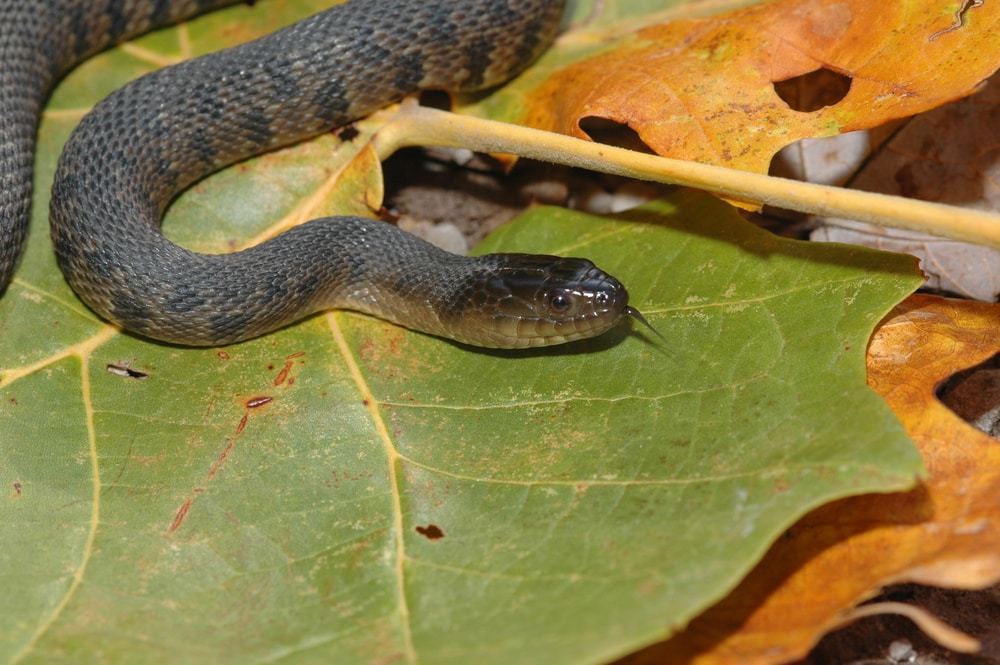
Mississippi green water snakes are commonly confused with the venomous cottonmouth despite being a nonvenomous species. They have dark bands that fade with age much like the cottonmouth, are usually almost entirely black, and are found often in or near the water.
On average, green water snakes grow to lengths between 30-55 inches (76-140 cm). They’re exceptionally rare in Florida, with only a few reports of them in the extreme western end of the Panhandle region.
39. Glossy Swampsnake
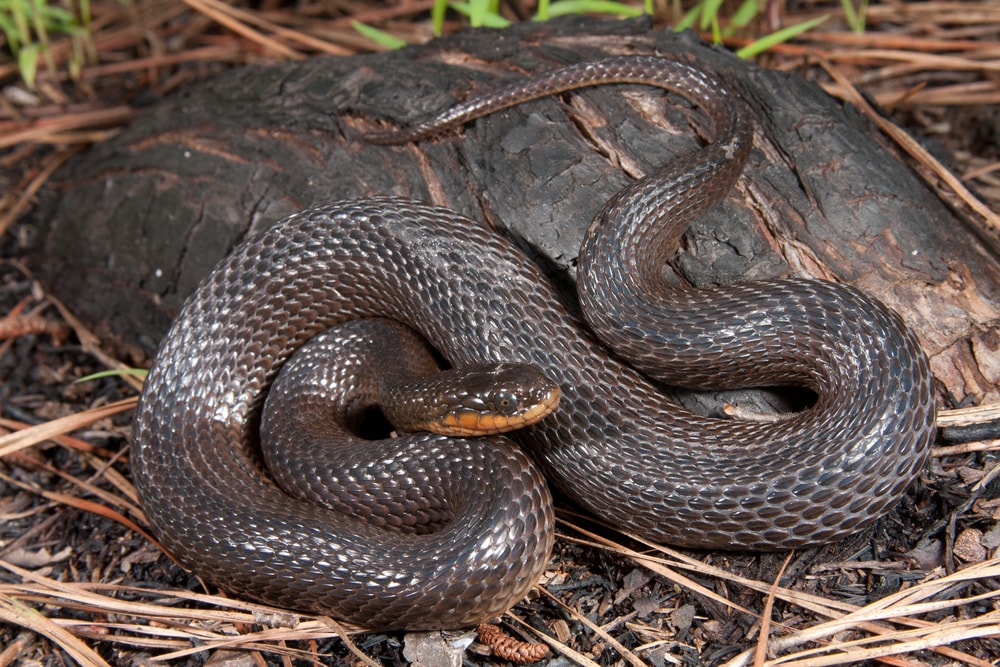
Glossy swamp snakes are typically a glossy brown or olive green color. They have large eyes with yellow eyelids and a yellow chin and throat area. It can be hard to see but many individuals have a faint dark stripe that runs down their side.
On average, glossy swamp snakes grow to lengths between 14-24 inches (36-61 cm). You can find them in Florida from Osceola County in the east, up through the Panhandle region.
40. Rough Earthsnake
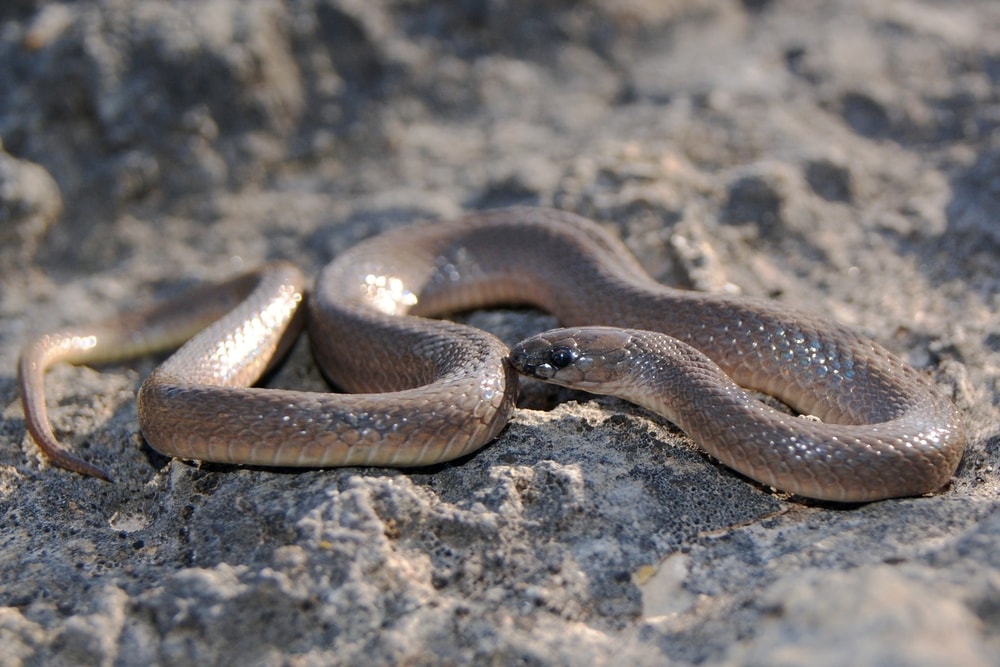
Rough earth snakes are usually a glossy brown or gray color with light yellow or white bellies. They have a distinctly pointed snout but no clear separation of neck or head. They may or may not have a lightly-colored ring just behind the head.
On average, rough earth snakes grow to lengths between 7-10 inches (18-26 cm). These nonvenomous snakes are found in the western panhandle and northern peninsula of Florida.
41. Appalachicola Kingsnake
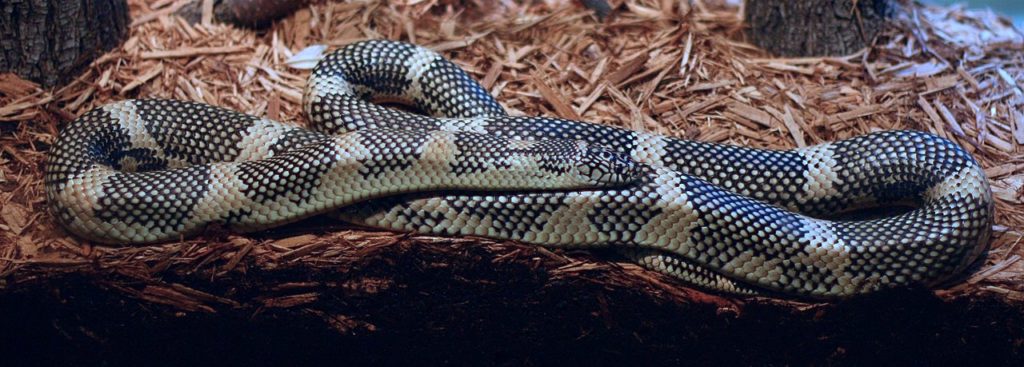
Appalachicola kingsnakes have similar body types to other kingsnakes. Their coloration can vary, but they generally have a light body coloration. They can have either narrow or wide bands or have no pattern at all. Some juveniles are completely black if they will have bands when adults, though adults typically have fewer than 23 bands in total.
On average, Appalachicola kingsnakes grow to lengths between 36-48 inches (90-122 cm). This nonvenomous species can be found in the central and eastern Panhandle region, centered mostly around Apalachicola (hence the name).
42. Plain-bellied Watersnake
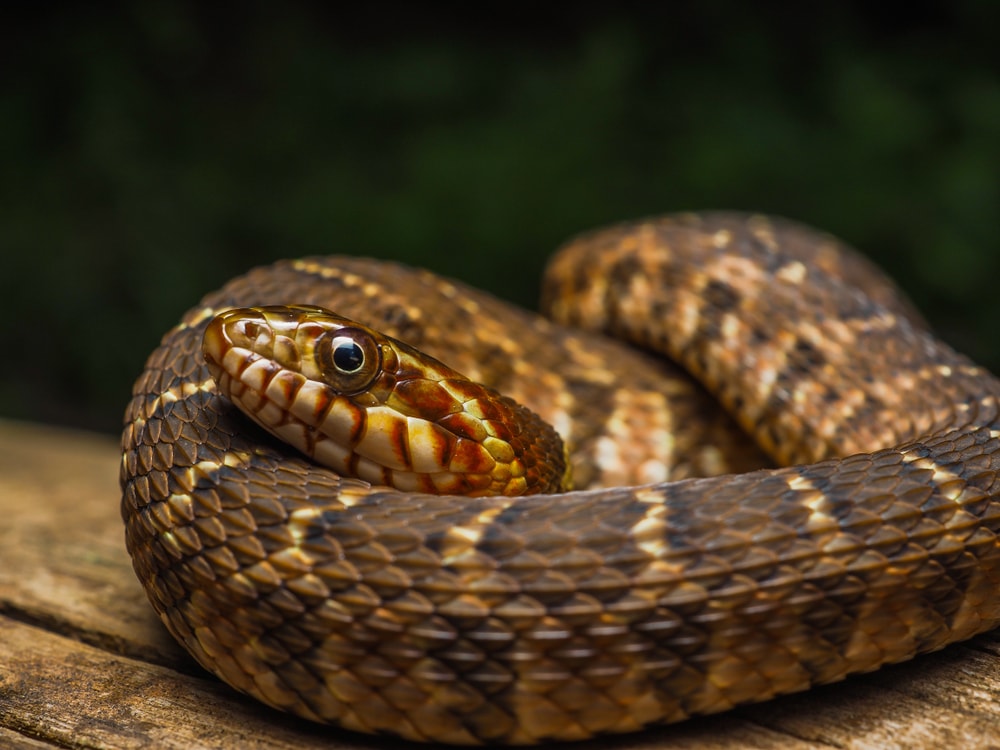
Plain-bellied water snakes are usually a uniform green-gray or reddish-brown color. Their undersides are usually a brighter yellow or orangish color and they have thick, stocky bodies without any patterning.
On average, these nonvenomous snakes grow to lengths between 30-48 inches (76-122 cm). They’re usually found in the western panhandle, but can also be located along the Santa Fe and Suwannee Rivers.
43. Southeastern Crowned Snake
The southeastern crowned snake is usually a reddish-brown or tan color with a dark-colored head. They have a light band just behind the head that kind of looks like a halo or a crown.
On average, these small, nonvenomous snakes grow to lengths between 8-10 inches (20-26 cm). They can be found in the Panhandle and east into Leon County in Florida.
44. Short-tailed Kingsnake
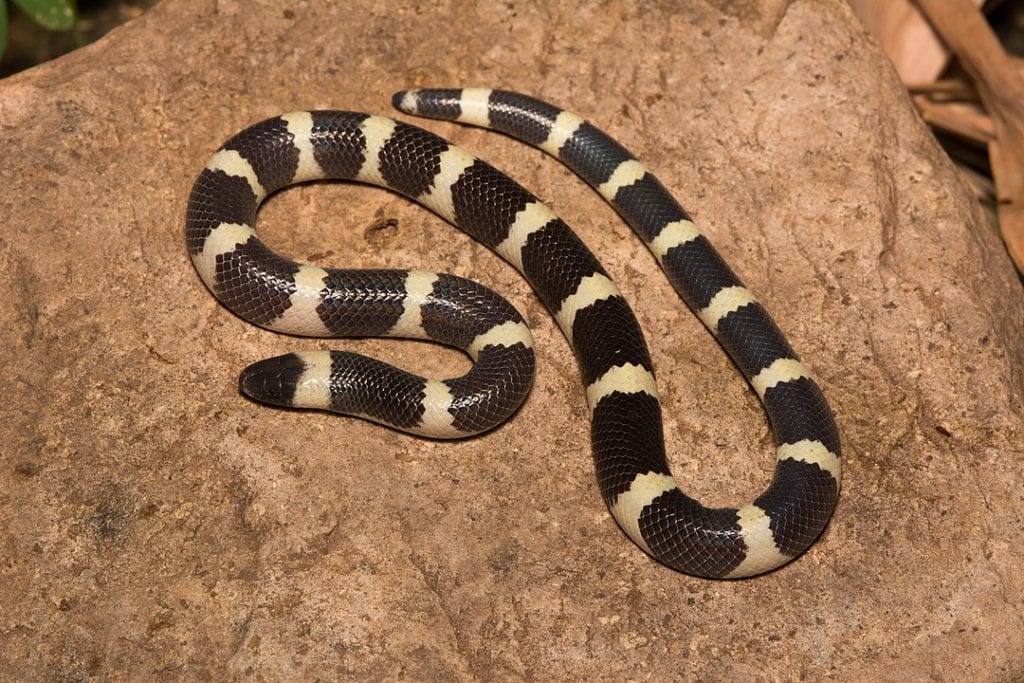
The short-tailed kingsnake is relatively smaller than other kingsnakes despite having a similar body shape. They’re slender with gray bodies and have patterns of dark splotches with an orange line (kind of) running down their back.
On average, short-tailed kingsnakes grow to lengths between 14-20 inches (36-51 cm). You can find this nonvenomous species west of the St. John’s River and in the upper area of central Florida. The species is only found within the state of Florida and nowhere else in the world.
45. Queensnake
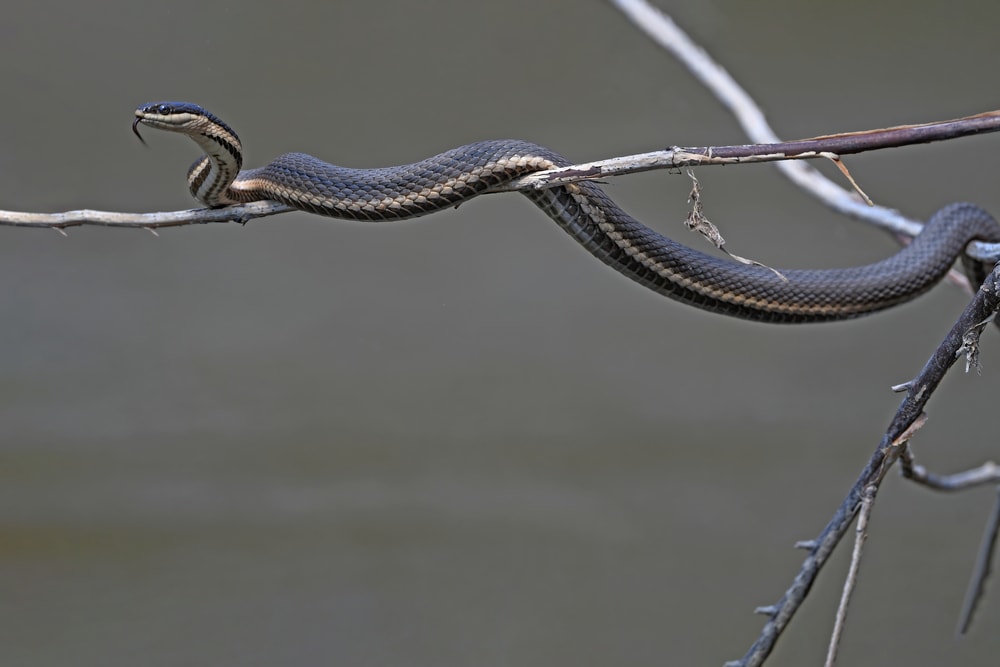
Queensnakes are usually a brown or olive green color with a cream or yellowish stripe on their underside. Their lip scales are much lighter than the rest of the head, giving it a distinct separation. Their scales have a noticeable ridge rising off the body.
On average, queensnakes grow to lengths between 15-24 inches (38-61 cm). You can find this nonvenomous snake throughout the Panhandle region, west of the Ochlockonee River.
46. South Florida Mole Kingsnake
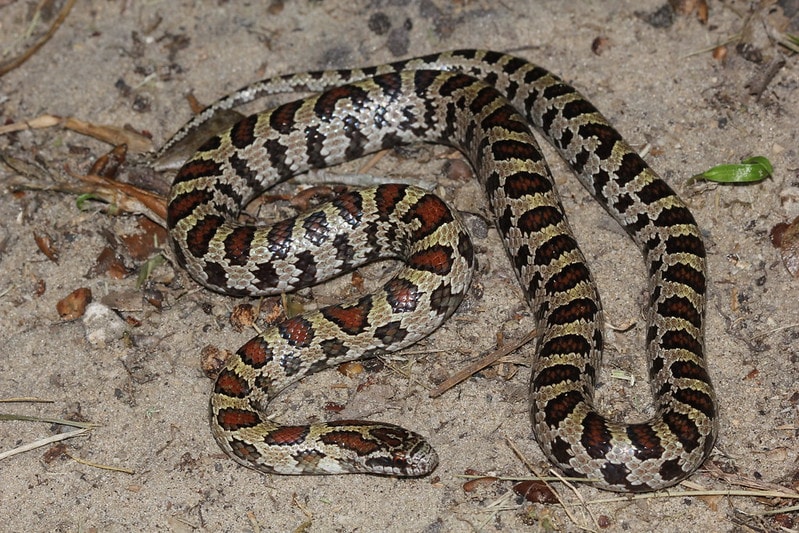
South Florida Mole Kingsnakes are usually a tan, brown, or gray color with at least 75 reddish-brown blotches running down the length of their body. They can also be almost entirely brown when they get to older ages. They tend to have a dark line that runs through their eye and dark markings on the back of their heads.
On average, south Florida kingsnakes grow to lengths between 30-42 inches (76-107 cm). You can find this nonvenomous species from Brevard County to Lake Okeechobee and westward to Charlotte and De Soto Counties. It is not found outside of Florida.
47. Southern Hog-nosed Snake

Southern hognose snakes are the little cousin of eastern hognose snakes. They can have bodies ranging from light gray, tan, yellowish-brown, or orangish-red and have dark blotches along their back or sides. They also have a very distinct, shovel-like snout.
On average, southern hognose snakes grow to lengths between 18-22 inches (45-55 cm). The nonvenomous species is mostly found in the Panhandle region, but can also be found along the St. John’s River.
48. Rim-rock Crowned Snake
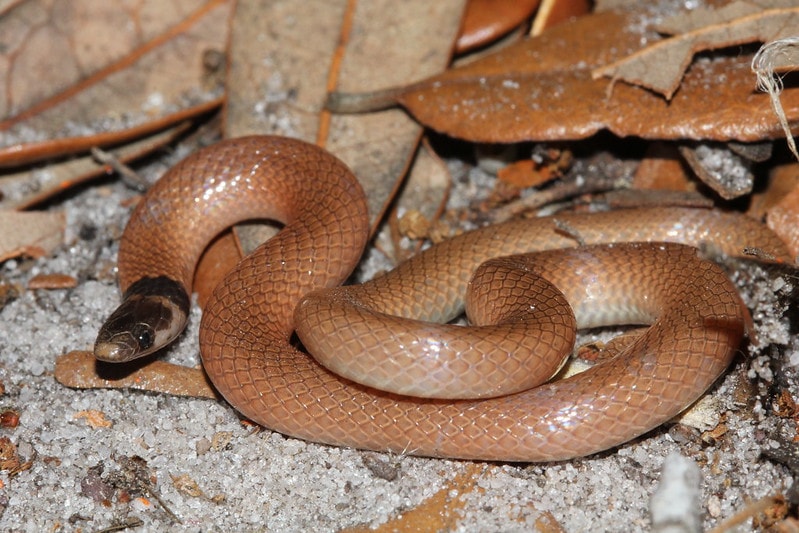
Also called the Miami black-headed snake, rim-rock crowned snakes are a light tan to pinkish-brown color and have a dark black head. They have tiny eyes and the tip of their snout is also a lighter color than the rest of their head.
On average, this nonvenomous snake grows to lengths between 7-9 inches (18-23 cm). You can only find it in Miami-Dade County, Monroe County, and within the Florida Keys from Key Largo to Key West.
49. Brahimy Blind Snake
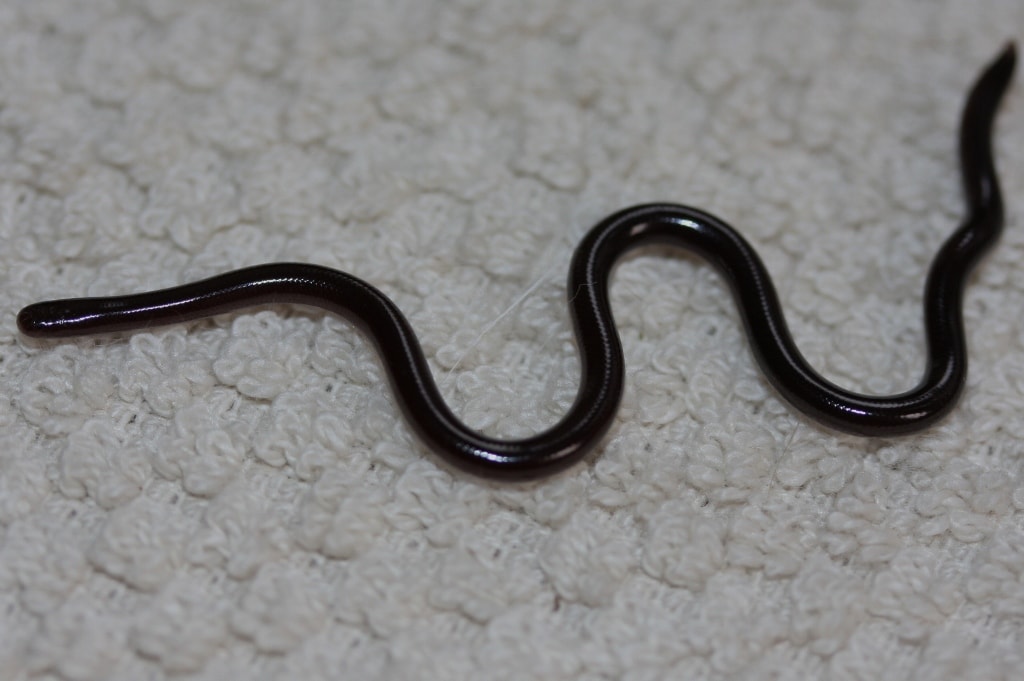
Brahminy blind snakes are tiny, with most individuals achieving a length of only 4.4–6.5 inches (11.2–16.5 cm). They can range in color from shiny silver gray, charcoal gray, or purple. Both the head and tail are blunt, making it difficult to tell which end is which.
Their tail has a tiny, sharp spur that helps them dig. Some people mistake them for earthworms and are surprised when they flick their tongues out. Thankfully, these snakes aren’t venomous.
Brahminy blind snakes aren’t native to Florida, originating in Southern Asia. They were first reported in Miami in the 1970s, but have since established a range from Key West through the entire peninsula, with some reports in the panhandle.
50. Javan File Snake
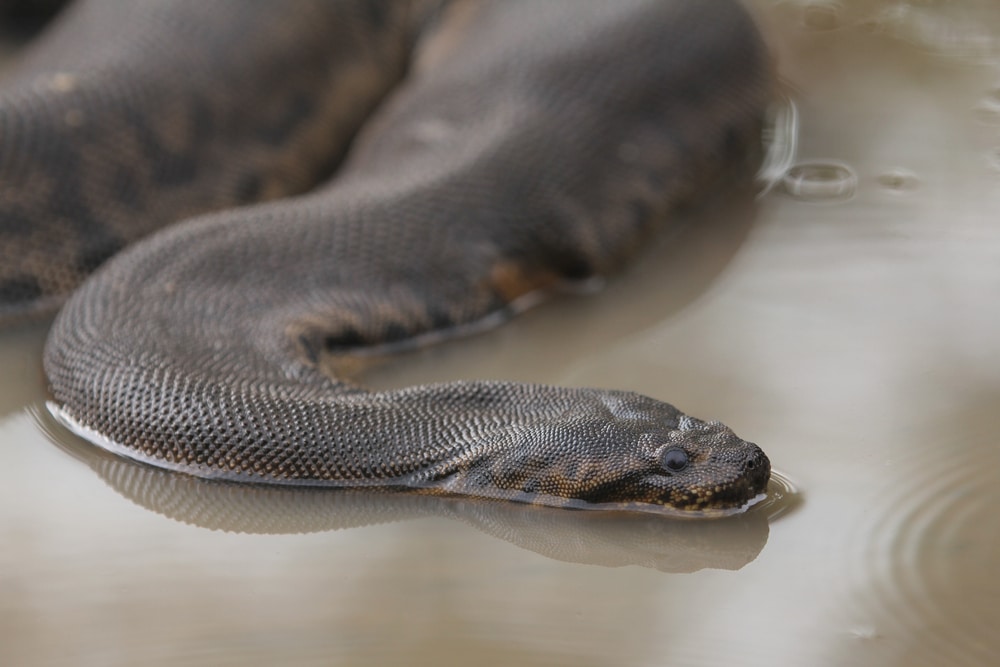
The Javan file snake is easy to identify thanks to its derpy-looking head. The head is flat and file-shaped, with large back eyes located on either side. Their body is mostly brown with a cream-colored belly. Their skin is loose and their scales feel like rough sandpaper.
On average, these snakes reach lengths of around 46 inches (118 cm) for males and 53 inches (135 cm) for females but are known to grow to nearly ten feet in length.
These nonvenomous snakes are not native to Florida and originated in Southeast Asia. They’ve been around in the state since the 1970s, likely brought over as pets.
They had a limited population in the wild to begin with, with only one known established location in a rock pit in Miami-Dade County. A 2003 trapping effort went unsuccessful and no solid population data has been gathered since then.
51. Boa Constrictor
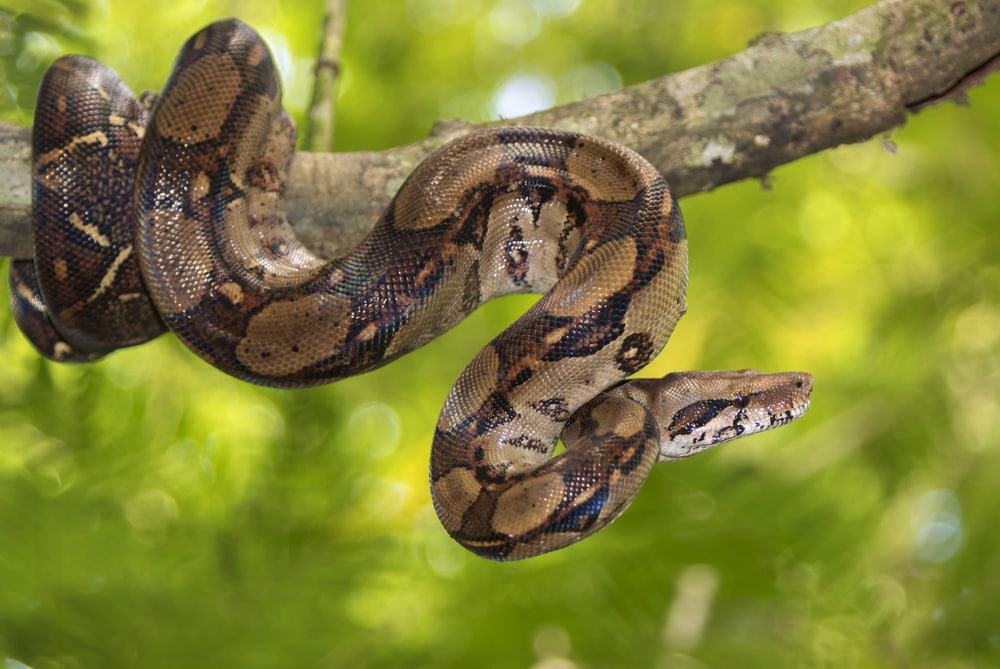
Boa constrictors are huge, stout-bodied snakes with an overall tan body and dark blotches along their length. This invasive constrictor snake has hourglass-shaped blotches starting around the neck area and dark markings behind its eyes.
On average, a boa constrictor can reach lengths between 10-16 feet (3-5 m) in total length.
Originally from Latin America, boa constrictors made their way to Florida primarily through the pet trade. Their only known established area is around the Charles Deering Estate in Miami, Miami-Dade County.
While nonvenomous, these huger snakes pose a significant threat to people, pets, and native wildlife.
52. Burmese Python
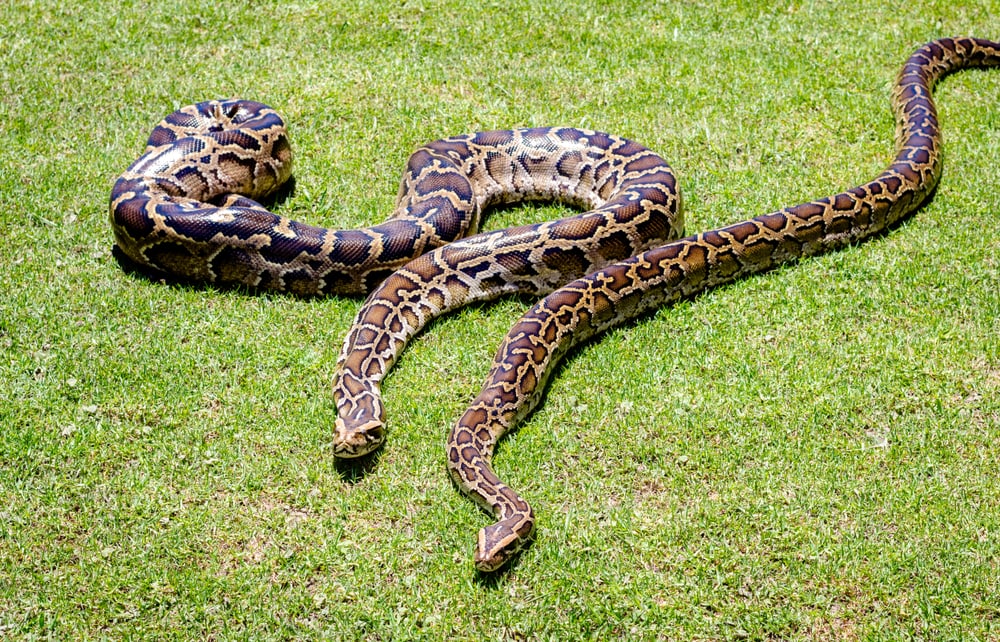
Burmese pythons are massive constrictors that were brought to Florida through the pet trade but were able to establish themselves primarily in the Everglades. They have black-bordered blotches on a brown to tan body, a dark and V-shaped head, and are hard to miss despite the camouflage.
On average, Burmese pythons grow to lengths between 10-16 feet (3-5 m) in total length. Larger specimens over twenty feet have been found in Florida swamps.
Originally from southern Asia, they’ve established themselves in Florida and can be found in the southern peninsula from Lake Okeechobee to Key Largo. Their largest numbers are located in the Everglades National Park.
While not a venomous snake, their large size, long fangs, and constricting ability do make them dangerous for people, pets, and native wildlife. Larger snakes are capable of eating dogs, deer, and even adult alligators.
53. African Rock Python
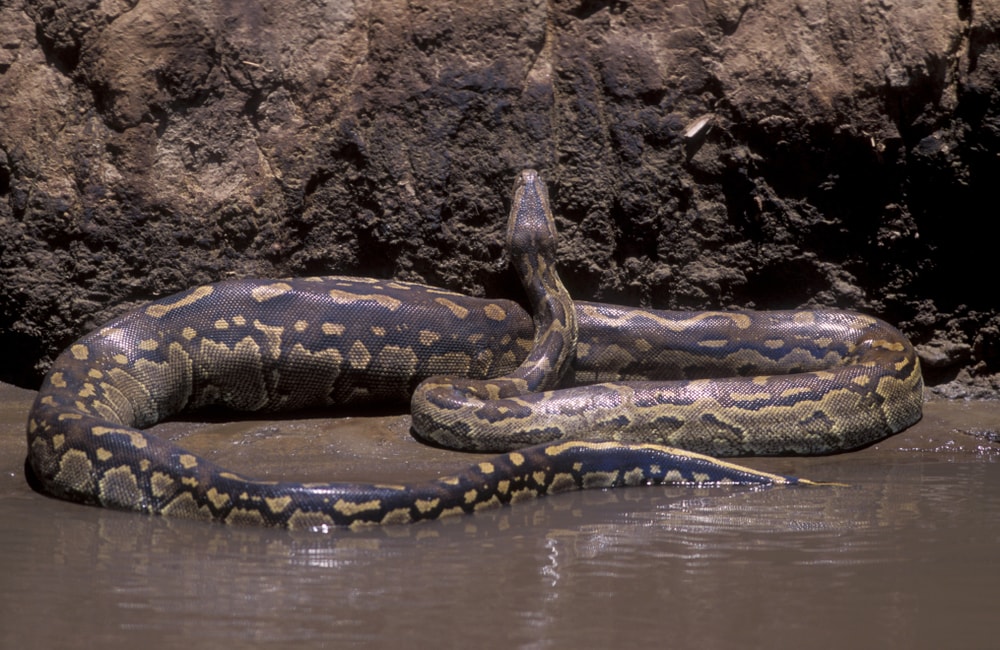
Like the Burmese python, the African rock python is an invasive constrictor species that aren’t native to Florida but found a home here. They have very similar colorations to Burmese pythons, they are just usually a more tan color.
On average, rock pythons grow to lengths between 10-16 feet (3-5 m) in total length. Like Burmese pythons, they can reach lengths well over that average.
Originally from sub-Saharan Africa, African rock pythons have established populations in Florida in Sarasota and Miami-Dade Counties. While not venomous, they pose a significant danger to people, pets, and native wildlife.
You may also like: Know More About the 28 Slithering Snakes in Colorado: Complete with Images, Facts, Descriptions, and More!
Invasive Species in Florida
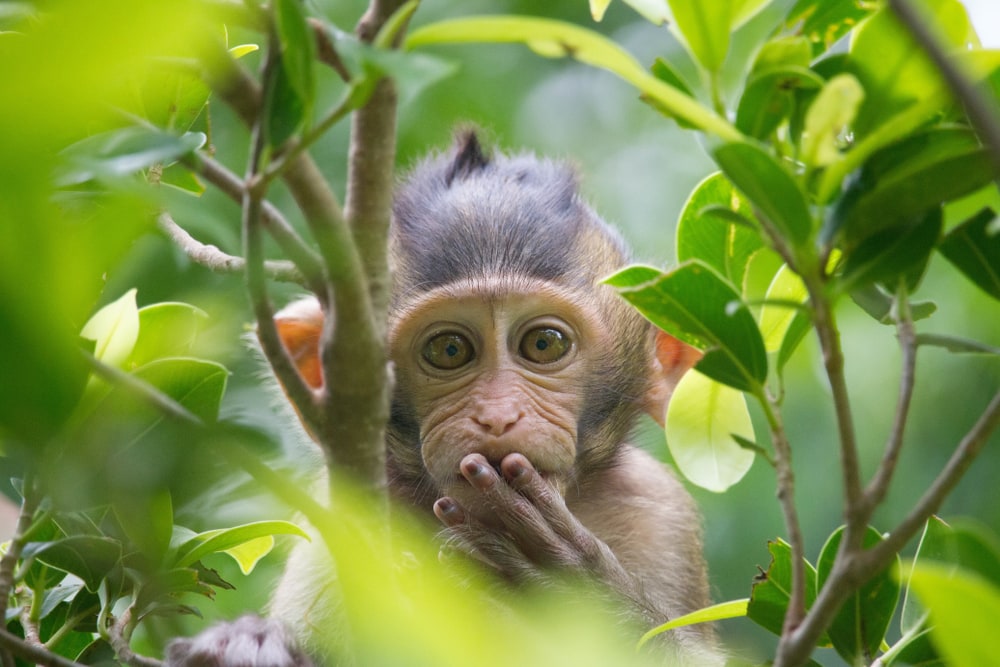
According to the FWC (Florida Fish and Wildlife Commission), there are reports of 40 invasive species of snakes in the state including cobras, anacondas, pythons, and boas of all kinds. Only the five known have established populations were included in the above list, however, you can find a full list here.
For more information about the dangers that invasive species (including Burmese pythons) pose for native species in Florida, check out Wild Monkeys In Florida: All About Them And How They Got There.
You May Also Like: Learn About The Largest Alligator Ever Recorded In Florida with Facts, State Records, and more!
FAQ
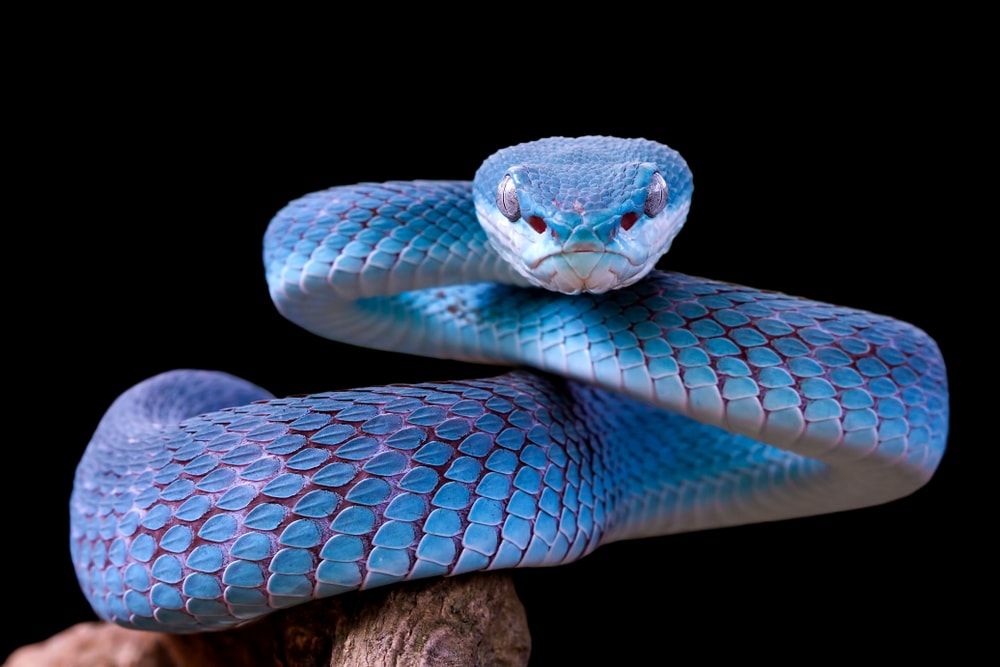
Is Florida an Ideal Habitat for Snakes?
Overall, Florida is an amazing habitat for snakes. Winter is almost always either incredibly mild or nearly nonexistent. The entire state is very humid, and there are plenty of food sources like frogs, eggs, rodents, and small animals for them to eat.
While it’s an ideal situation temperature, humidity, and habitat wise, snakes usually don’t congregate in groups. For the most part, they’re fairly spread out over large areas and you won’t run into many pockets of densely snake-infested areas in the state.
How dangerous are the snakes in Florida?
From personal experience, snakes aren’t bad in Florida. I live in the Panhandle and I’ve seen four snakes in my neighborhood in the last 15 years. How bad they are depends on how much time you spend in areas they want to be more than anything else, since they’re really widespread and don’t want to be around people.
In South Florida, the populations of huge snakes like boas and pythons are mostly isolated to the Everglades and will very rarely wander into urban environments. It’s a great habitat and climate for snakes, so they’re going to be around. It’s just a lot rarer than you think that you’d run into them.
A PSA: What to do if you see a snake?
The best thing to do if you see a snake is to leave it alone. Most of the time, snakes are just trying to live their lives and will leave you alone if you leave them alone. Accidentally getting too close before you see it can result in a conflict, so try to be aware of your surroundings.
Snakes typically will just leave an area. Larger snakes will travel across sizable distances most days, so seeing a snake in your yard doesn’t mean it will be around tomorrow. You can reduce your chances of having snakes around by reducing the habitat area for mice near your home.
Remove brush, yard debris, or dilapidated buildings from your yard. Also, try to tidy up from bird feeder spills. These things can attract rodents, and in turn, bring snakes to your home as they search for a meal.
Try to identify the snake you see. You can use this guide as a decent way to figure out what snake species you’re looking at. Florida is home to a few endangered species of snakes. Unless you or your pets are in immediate danger, there is really no good reason to kill a snake.
I’ll add to that last statement about
not killing snakes by saying this is true most of the time. If you do come across an invasive species such as a Burmese python, the best thing to do is to either kill the snake or alert the Fish and Wildlife Service to have it removed.
You may also like:
Discover different species found in Florida here:

Wild Monkeys In Florida | Poisonous Frogs In Florida | Anoles In Florida | Birds Of Florida | Vultures In Florida | Woodpeckers In Florida | Hawks In Florida | Florida Freshwater Fish | Florida Frogs | Scorpions In Florida | Geckos In Florida | Florida Spiders | Lizards In Florida | Owls In Florida | Florida Turtles | Alligators In Texas | Sharks in Florida | Largest Alligator In Florida | Beach Birds Of Florida |









